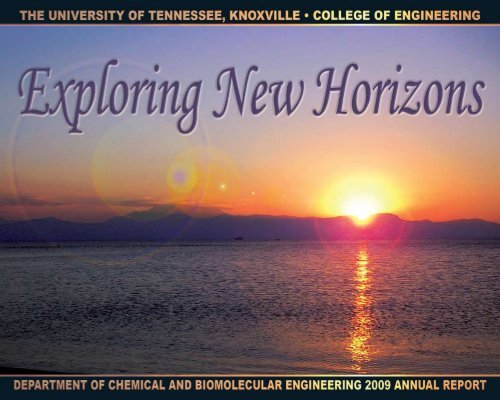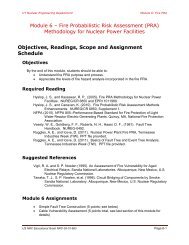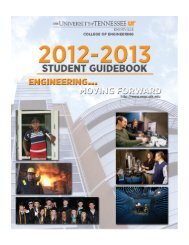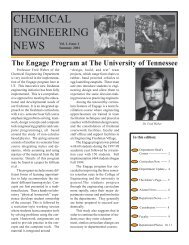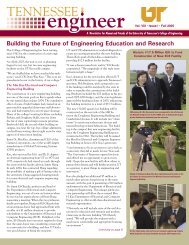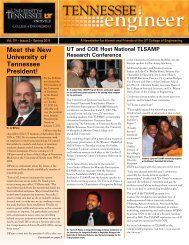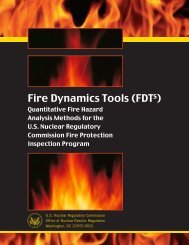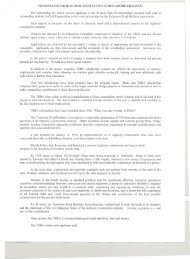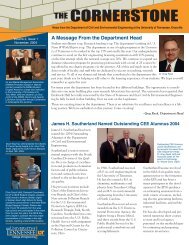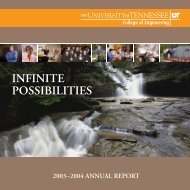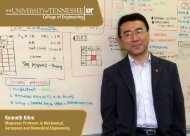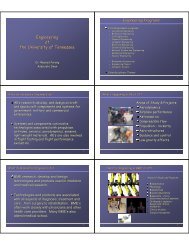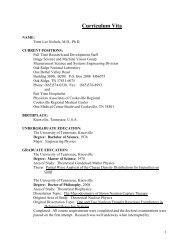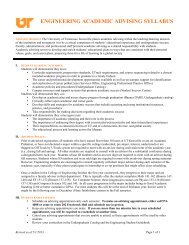CBE 2009 Annual Report - College of Engineering - The University ...
CBE 2009 Annual Report - College of Engineering - The University ...
CBE 2009 Annual Report - College of Engineering - The University ...
Create successful ePaper yourself
Turn your PDF publications into a flip-book with our unique Google optimized e-Paper software.
FOR INFORMATION ON THE DEPARTMENT OF CHEMICAL AND BIOMOLECULAR ENGINEERING VISIT HTTP://WWW.ENGR.UTK.EDU/<strong>CBE</strong>/<br />
DEPARTMENT OF<br />
CHEMICAL AND<br />
BIOMOLECULAR<br />
ENGINEERING <strong>2009</strong><br />
ANNUAL REPORT<br />
A project <strong>of</strong> the <strong>University</strong><br />
<strong>of</strong> Tennessee <strong>College</strong> <strong>of</strong><br />
<strong>Engineering</strong> Office <strong>of</strong><br />
Communications<br />
WRITER & EDITOR<br />
Kim Cowart<br />
Communications Director<br />
DESIGN &<br />
PRODUCTION<br />
Mitchell Williamson<br />
Graphic Designer<br />
WRITER<br />
L. Ashley Susong<br />
Communications Assistant<br />
CONTRIBUTING<br />
PHOTOGRAPHERS<br />
Nick Myers,<br />
UT Photo Services<br />
Rip Noel,<br />
Rip Noel Studios<br />
L. Ashley Susong<br />
Nature Images from<br />
“Panoramic Landscapes”<br />
Photodisc ® by Getty Images<br />
<strong>The</strong> information in this report<br />
reflects the time period from<br />
July 1, 2008- June 30, <strong>2009</strong><br />
<strong>The</strong> <strong>University</strong> <strong>of</strong> Tennessee is an<br />
EE)/AA/Title VI/Title IX/Section<br />
504/ADA/ADEA institution in<br />
the provision <strong>of</strong> its education<br />
and employment programs and<br />
services. All qualified applicants<br />
will receive equal consideration for<br />
employment without regard to race,<br />
color, national origin, religion, sex,<br />
pregnancy, marital status, sexual<br />
orientation, gender identity, age,<br />
physical or mental disability or<br />
covered veteran status.<br />
CONTENTS<br />
Department Head’s Message<br />
Dr. Bamin Khomami<br />
Research Feature<br />
Dr. Eric Boder<br />
Governor’s Chair<br />
Dr. Thomas Zawodzinski<br />
New Faculty Member<br />
Dr. Paul Dalhaimer<br />
Outstanding Graduate Student<br />
Arash Abedijaberi<br />
Outstanding Undergraduate Student<br />
Mark May<br />
Outstanding Alumnus<br />
Jerry Johnson<br />
Renowned Lecturers<br />
Dr. G. M. Homsy<br />
Dr. Ronald Lawson<br />
Faculty Listing<br />
<strong>CBE</strong> Board <strong>of</strong> Advisors<br />
Honors and Awards<br />
Publications, Contracts,<br />
Grants and Presentations<br />
Donor List<br />
PAN: E01-1320-031-10<br />
DOP: 1/22/10<br />
©2010 <strong>The</strong> <strong>University</strong> <strong>of</strong> Tennessee<br />
Office <strong>of</strong> <strong>Engineering</strong> Communications.<br />
All rights reserved. Cover photo by Dr. Brian J. Edwards<br />
Financial Information<br />
1<br />
2<br />
4<br />
5<br />
6<br />
8<br />
10<br />
11<br />
12<br />
14<br />
15<br />
16<br />
21<br />
22<br />
“ <strong>The</strong> global energy crisis<br />
has made abundantly<br />
clear the need for, new,<br />
sustainable, economic and<br />
environmentally friendly<br />
means <strong>of</strong> energy production.<br />
This translates into<br />
unprecedented opportunities<br />
for chemical engineers, who<br />
are uniquely positioned<br />
among the engineering<br />
disciplines to tackle these<br />
enormous challenges. ”<br />
As I enter my fourth year as Department Head <strong>of</strong><br />
Chemical and Biomolecular <strong>Engineering</strong> at the<br />
<strong>University</strong> <strong>of</strong> Tennessee, it is readily apparent that it<br />
is a very exciting time to be a chemical engineer. <strong>The</strong><br />
global energy crisis has made abundantly clear the need<br />
for new, sustainable, economic and environmentally<br />
friendly means <strong>of</strong> energy production. This translates into<br />
unprecedented opportunities for chemical engineers,<br />
who are uniquely positioned among the engineering<br />
disciplines to tackle these enormous challenges.<br />
Here at the <strong>University</strong> <strong>of</strong> Tennessee, we are keenly<br />
focused on these future challenges, and, as indicated<br />
on the cover, are rapidly expanding our departmental<br />
horizons to face the changing energy environment.<br />
Last year, I reported the department’s efforts at<br />
establishing and leading a new center within the<br />
<strong>University</strong> <strong>of</strong> Tennessee-Knoxville, the Sustainable<br />
Energy Education and Research Center (SEERC).<br />
This center is now fully operational and funded, both<br />
through internal sources and competitive external<br />
grants. It is now providing seed grants to collaborative<br />
research groups to study novel methods <strong>of</strong> energy<br />
production and utilization, which hopefully will lead to<br />
further innovation and research productivity.<br />
Our department has also taken the lead in the<br />
Sustainable Technology through Advanced<br />
Interdisciplinary Research (STAIR) program, which<br />
was funded in 2008 through a grant from the National<br />
Science Foundation. This program is dedicated to<br />
the recruitment and training <strong>of</strong> Ph.D. students in<br />
sustainable energy research activities. During the<br />
current year, the program has shifted into high gear<br />
after last year’s successful start-up phase. At this time,<br />
Department Head’s Message From Dr. Bamin Khomami<br />
12 graduate students are taking advantage <strong>of</strong> this<br />
unique opportunity.<br />
Research within our department is still maintaining the<br />
momentum it achieved during the past two years. Our<br />
active grants total approximately $11M, representing<br />
a 2.5-fold increase from three years ago. Our research<br />
portfolio now includes external grants from essentially<br />
every federal funding agency, including the National<br />
Science Foundation, the Department <strong>of</strong> Energy, the<br />
Department <strong>of</strong> Defense, the American Chemical<br />
Society, the Federal Bureau <strong>of</strong> Investigation and, for the<br />
first time in 2007, the National Institute <strong>of</strong> Health. We<br />
also have industrially and national laboratory sponsored<br />
research projects with Eastman Chemical Co. and Oak<br />
Ridge National Laboratory. Commensurate with this<br />
growth in our research funding, the number <strong>of</strong> Ph.D.<br />
students in our program has doubled in the past three<br />
years to a total <strong>of</strong> 33. Our undergraduate enrollment has<br />
also nearly doubled in the same period.<br />
<strong>The</strong> department was extremely fortunate to attract two<br />
new faculty members during the past year. Dr. Thomas<br />
Zawodzinski joined us in August as one <strong>of</strong> the new<br />
Governor’s Chairs in Electric Energy Storage. Tom will<br />
add to our already considerable strengths in fuel cells.<br />
In addition, he has started a very large research initiative<br />
in energy storage and battery technologies. Dr. Paul<br />
Dalhaimer also joined us as a new assistant pr<strong>of</strong>essor<br />
from the <strong>University</strong> <strong>of</strong> Pennsylvania after a postdoctoral<br />
fellow position at Yale <strong>University</strong>. Paul mainly works in<br />
the area <strong>of</strong> drug delivery with special emphasis on lung<br />
carcinoma, and has outstanding potential to become a<br />
leading innovator in this area. We currently have two<br />
open searches at the assistant pr<strong>of</strong>essor level.<br />
Bamin Khomami<br />
Armour T. Granger and Alvin & Sally Beaman<br />
Distinguished <strong>University</strong> Pr<strong>of</strong>essor and Head <strong>of</strong><br />
Chemical and Biomolecular <strong>Engineering</strong><br />
Although there is still much more to accomplish,<br />
the department has already made significant strides<br />
toward gaining a national reputation in only three<br />
years. Over the next several years, continued effort will<br />
be expended to realize the department’s full potential.<br />
Great success is anticipated with continued innovation<br />
and relentless effort.<br />
1
Research Focus: Dr. Eric Boder<br />
“Our hope is that our research will point the way to new ‘smart’<br />
materials for use in biosensors and to enhanced approaches to<br />
vaccination,” Boder said. “We’ve got a lot <strong>of</strong> work ahead, but<br />
I’m very excited about the possibilities.”<br />
Eric Boder, an associate pr<strong>of</strong>essor<br />
in the Department <strong>of</strong> Chemical and<br />
Biomolecular <strong>Engineering</strong> (<strong>CBE</strong>), is<br />
a faculty member whose research is<br />
uncovering exciting new territory.<br />
Boder has been at UT for two years.<br />
He received his Ph.D. at the <strong>University</strong><br />
<strong>of</strong> Illinois and was awarded a National<br />
Science Foundation (NSF) CAREER<br />
Award in 2003.<br />
Boder’s research areas are molecular<br />
biotechnology and bioengineering,<br />
protein engineering and directed<br />
evolution. <strong>The</strong> primary goal<br />
<strong>of</strong> his work is to change the<br />
properties <strong>of</strong> molecules in order<br />
to create proteins that might be<br />
useful as components in drug<br />
delivery devices or biosensors.<br />
He is collaborating with a former<br />
colleague at the <strong>University</strong><br />
<strong>of</strong> Pennsylvania to study and<br />
engineer a protein that regulates<br />
the capability <strong>of</strong> immune cells to<br />
adhere to blood vessel walls at sites<br />
<strong>of</strong> inflammation, a capability that<br />
would be desirable for delivering<br />
therapeutics.<br />
Boder is also engaging in multidisciplinary<br />
research with several<br />
pr<strong>of</strong>essors at the <strong>University</strong> <strong>of</strong><br />
Tennessee.<br />
“I’m becoming involved in a<br />
sustainable energy project with<br />
a number <strong>of</strong> faculty here at UT,<br />
including Paul Frymier in <strong>CBE</strong>.<br />
We are directing our efforts to<br />
develop an approach for producing<br />
hydrogen from sunlight using<br />
biological materials,” Boder<br />
said. “I will also be working with<br />
Barry Bruce, a pr<strong>of</strong>essor in the<br />
Biochemical, Cellular and Molecular<br />
Biology Department and Hugh<br />
O’Neill, who is a biochemist at Oak<br />
Ridge National Laboratory (ORNL).”<br />
Boder’s primary sources <strong>of</strong> research<br />
funding are the NSF and the<br />
National Institute <strong>of</strong> Health (NIH).<br />
He has also received grants from<br />
the Whitaker Foundation and Merck<br />
Foundation.<br />
“Historically, our research has<br />
been biomedically focused,” Boder<br />
added. “Although we still have a lot<br />
<strong>of</strong> interest in biomedical research,<br />
we’re diversifying thanks to the<br />
environment and colleagues at UT<br />
and ORNL.”<br />
Boder is currently putting together<br />
a research publication that will<br />
outline his results with class II MHC,<br />
a protein fundamentally involved<br />
in regulating immune responses.<br />
<strong>The</strong> primary aim <strong>of</strong> this research is<br />
to develop a tool that will create<br />
a better understanding <strong>of</strong> which<br />
antigens might induce an immune<br />
response and allow fine-tuning <strong>of</strong><br />
those responses.<br />
“Our hope is that our research<br />
will point the way to new ‘smart’<br />
materials for use in biosensors<br />
and to enhanced approaches to<br />
vaccination,” Boder said. “We’ve got<br />
a lot <strong>of</strong> work ahead, but I’m very<br />
excited about the possibilities.”<br />
2 3
<strong>The</strong> Governor’s Chair in Electrical <strong>Engineering</strong> Storage: Thomas Zawodzinski<br />
4<br />
<strong>The</strong> Governor’s Chair program at the <strong>University</strong> <strong>of</strong><br />
Tennessee attracts top scientists to broaden and<br />
enhance the unique research partnership that<br />
exists between the state’s flagship university and<br />
Oak Ridge National Laboratory (ORNL), the nation’s<br />
largest multi-program laboratory. <strong>The</strong> initiative is<br />
funded by the State <strong>of</strong> Tennessee and ORNL.<br />
<strong>The</strong> program is primarily designed to provide an<br />
opportunity for accomplished researchers from<br />
around the world to enhance joint research efforts<br />
that position the partnership as a leader in the<br />
fields <strong>of</strong> biological science, computational science,<br />
advanced materials and neutron science. Over<br />
$20 million in designated funding from the state<br />
and ORNL is being invested to recruit and fund<br />
the positions, including resources to support new<br />
research programs.<br />
In August <strong>2009</strong>, Dr. Thomas Zawodzinski was named<br />
as the Governor’s Chair in Electrical Energy Storage.<br />
Zawodzinski is the third Governor’s Chair in the<br />
engineering college and the fifth for the university.<br />
Zawodzinski received his Ph.D. in chemistry from<br />
State <strong>University</strong> <strong>of</strong> New York in Buffalo, N.Y. His thesis<br />
work, under the supervision <strong>of</strong> Pr<strong>of</strong>essor Robert<br />
Osteryoung, dealt with the physical and chemical<br />
studies <strong>of</strong> ambient temperature ionic liquids.<br />
Zawodzinski is an internationally recognized leader<br />
in the field <strong>of</strong> fuel cells, bridging fundamental and<br />
applied studies to drive innovation in materials and<br />
cell design. He has also carried out prior work on<br />
batteries, most notably on transport in materials for<br />
lithium batteries.<br />
Zawodzinski was previously the F. Alex Nason<br />
Pr<strong>of</strong>essor <strong>of</strong> <strong>Engineering</strong>, the Ohio Eminent Scholar<br />
for Fuel Cells and the director <strong>of</strong> the Case Advanced<br />
Power Institute in the Department <strong>of</strong> Chemical<br />
<strong>Engineering</strong> at Case Western Reserve <strong>University</strong>.<br />
During his tenure at Case, he led a highly successful<br />
multi-university ARO-funded MURI on “Integrated<br />
Computational and Experimental Studies <strong>of</strong> Fuel<br />
Cell Electrocatalysis” that included participation by<br />
researchers at Case, the Massachusetts Institute <strong>of</strong><br />
Technology, the <strong>University</strong> <strong>of</strong> Virginia, the <strong>University</strong><br />
<strong>of</strong> Illinois, Rice <strong>University</strong> and Northeastern<br />
<strong>University</strong>. In 2002, Zawodzinski led efforts to build<br />
the Wright Fuel Cell Group, utilizing a $20 million<br />
capital grant to establish a university-industry<br />
consortium in Ohio.<br />
Zawodzinski will be based in the Chemical and<br />
Biomolecular <strong>Engineering</strong> Department at UT and<br />
in the Physical Chemistry <strong>of</strong> Materials Group at<br />
ORNL. As part <strong>of</strong> this group, Zawodzinski will help<br />
to expand and develop multi-disciplinary programs<br />
in electrical energy storage, fuel cells and other<br />
relevant areas.<br />
Dr. Paul Dalhaimer, who has recently joined<br />
the Department <strong>of</strong> Chemical and Biomolecular<br />
<strong>Engineering</strong> as an assistant pr<strong>of</strong>essor, enjoys the<br />
constant challenges <strong>of</strong> his field.<br />
“I became interested in science in general when I<br />
found out that time isn’t constant,” Dalhaimer said.<br />
“So originally I wanted to study mathematical physics<br />
but I worried that jobs would be scarce in that area.<br />
<strong>The</strong> chemical and biomolecular engineering field<br />
draws from chemistry, physics, mathematics and<br />
now biology. It is a very versatile–and sometimes<br />
overwhelming–discipline. I tried to make a safe bet<br />
and went with an eclectic field.”<br />
Dalhaimer, who received his Ph.D. in chemical<br />
and biomolecular engineering at the <strong>University</strong> <strong>of</strong><br />
Pennsylvania, was recently a postdoctoral Fellow in<br />
molecular, cellular and developmental biology at<br />
Yale <strong>University</strong>.<br />
“During my time at Yale, I worked on a protein<br />
complex called Arp2/3. <strong>The</strong> proteins that give the<br />
‘push’ to the front edge <strong>of</strong> a motile cell (e.g. amoeba)<br />
form a structure that looks like a tree in winter. In<br />
this analogy the trunk/roots point toward the<br />
center <strong>of</strong> the cell and the branches point outward<br />
in the direction the cell is moving,” Dalhamier<br />
explained. “Simply put, if cells didn’t have Arp2/3<br />
complex our ‘tree’ would be a wooden pole: Arp2/3<br />
is responsible for the branching. <strong>The</strong> lab that I was<br />
in used many techniques to study Arp2/3 complex:<br />
fluorescent tagging in yeast, x-ray crystallography<br />
<strong>of</strong> purified complex, molecular dynamics <strong>of</strong> the<br />
subsequent crystal structure and more.”<br />
Dalhamier became interested in becoming a<br />
university pr<strong>of</strong>essor while a freshman at the<br />
<strong>University</strong> <strong>of</strong> Pennsylvania. He is excited about the<br />
opportunities that his new position <strong>of</strong>fers.<br />
“<strong>College</strong> is an unusual thing in that a student learns a<br />
massive amount <strong>of</strong> material in a short period <strong>of</strong> time<br />
but the student doesn’t really apply it then and there<br />
(my first job out <strong>of</strong> college was to figure out how<br />
large the bolts should be on the base <strong>of</strong> a sign so it<br />
doesn’t fall over: no chemical reactions!). Graduate<br />
school is a little more ideal in the sense that one takes<br />
classes while being in a laboratory so the opportunity<br />
for application is there. In short we don’t know what<br />
the future graduates will do–I want them to gain<br />
a general savvy for problem solving that can be<br />
applied to most anything,” Dalhaimer added.<br />
Dalhaimier’s move to the state <strong>of</strong> Tennessee has<br />
<strong>of</strong>fered him a new area <strong>of</strong> research.<br />
“I have been told that Tennessee is the third most<br />
obese state in the country,” Dalhaimer said. “Part <strong>of</strong><br />
the research in my laboratory works on the molecule<br />
mechanisms <strong>of</strong> obesity. Cells have organelles called<br />
lipid droplets that basically store fat. Excess numbers<br />
and size <strong>of</strong> lipid droplets in our cells cause health<br />
problems. We use fission yeast as a model system<br />
to study the formation <strong>of</strong> lipid droplets. We are<br />
interested in the atomistic structure <strong>of</strong> the droplets,<br />
for this we are collaborating with Oak Ridge National<br />
Laboratory (ORNL). We also work on drug delivery<br />
vehicles that are actually not much different in<br />
structure from the lipid droplets but the vehicles<br />
carry drugs instead <strong>of</strong> fat. At the present we are<br />
working on understanding the interactions <strong>of</strong> our<br />
drug carrying vehicles with a lymphoma cell line.<br />
New Faculty Member: Paul Dalhaimer<br />
A long-term goal <strong>of</strong> our laboratory would be to<br />
discover and deliver drugs that reduce the size <strong>of</strong><br />
lipid droplets in human tissue in a healthy way.”<br />
Dalhaimer looks forward to working with the faculty,<br />
staff and students in the <strong>CBE</strong> department.<br />
“My plan is simple: to provide my future students and<br />
post-docs with guidance and funding so that they<br />
can succeed and hopefully be found on the scientific<br />
map,” he said.<br />
5
Outstanding Graduate Student Arash Abedijaberi<br />
6<br />
When he was growing up in Isfahan, Iran, Arash<br />
Abedijaberi had no idea that his academic pursuits<br />
would lead him to the doctoral program in the<br />
Department <strong>of</strong> Chemical and Biomolecular <strong>Engineering</strong><br />
(<strong>CBE</strong>) at the <strong>University</strong> <strong>of</strong> Tennessee, but he has been<br />
here since 2007.<br />
Before he made his journey to the United States,<br />
Abedijaberi attended a different UT: the <strong>University</strong> <strong>of</strong><br />
Tehran. He received his bachelor’s and master’s in the<br />
prestigious Department <strong>of</strong> Biotechnology.<br />
“To be accepted in this program, I had to be among<br />
the top one percent in the national entrance exam for<br />
colleges in Iran,” Abedijaberi said. “My rank became<br />
51 out <strong>of</strong> 1.4 million participants.”<br />
Abedijaberi then moved to St. Louis, Mo.<br />
to study for his Ph.D. from Washington<br />
<strong>University</strong>. It was while at WashU that he<br />
met Dr. Bamin Khomami, who became<br />
his advisor. When Khomami accepted<br />
his position as the Granger and Beaman<br />
Distinguished <strong>University</strong> Pr<strong>of</strong>essor and<br />
Head <strong>of</strong> <strong>CBE</strong>, Abedijaberi reevaluated<br />
his academic plans.<br />
“I am very interested in doing research,<br />
teaching and seeking a faculty position,”<br />
Abedijaberi added. “I decided to work<br />
with only the best people in my field,<br />
and this was the main reason I decided<br />
to transfer to UT and continue working<br />
with Dr. Khomami.”<br />
Abedijaberi completed a second<br />
master’s in environmental, energy and<br />
chemical engineering before following<br />
Khomami to <strong>The</strong> Hill. Abedijaberi’s<br />
interest in chemical and biomolecular<br />
engineering stems from his interest in<br />
and undergraduate study <strong>of</strong> biological<br />
systems. It was under Khomami’s<br />
guidance that Abedijaberi transitioned<br />
from the realm <strong>of</strong> biotechnology and<br />
chemistry into engineering.<br />
“I always enjoyed studying about the<br />
genetics <strong>of</strong> biological organisms,”<br />
Abedijaberi said. “I felt in order to be<br />
able to use these systems for the human<br />
benefit, I needed to be an engineer, and<br />
I decided to change my field.”<br />
“ In my twenty years in academia, I have been very fortunate to work with many gifted graduate<br />
students in my research group. Rarely have I met an individual with as many multiple talents as<br />
Arash. He possesses outstanding analytical thinking ability and great leadership skills on top <strong>of</strong><br />
an impeccable character and a pleasant personality. It has been a joy to watch Arash develop and<br />
mature as a scientist. I am looking forward to watching him go to the next stage <strong>of</strong> his career as<br />
an academician. I foresee a very successful journey. ”<br />
– Dr. Bamin Khomami<br />
Abedijaberi enjoys a challenge, and<br />
making the move into engineering<br />
certainly provided him with one.<br />
“Initially, I received the lowest grade<br />
on the first exam and the highest on<br />
the last exam,” he said. “This is how I<br />
broke through my fear <strong>of</strong> chemical<br />
engineering as a biologist.”<br />
Abedijaberi’s research focuses on the<br />
simulation <strong>of</strong> complex flows <strong>of</strong> Non-<br />
Newtonian fluids. Non-Newtonian<br />
fluids exhibit behavior unlike water,<br />
and Abedijaberi wants to predict<br />
their behavior on the industrial level.<br />
He must describe these materials with<br />
nonlinear partial differential equations<br />
by using supercomputers and then<br />
develop numerical algorithms to solve<br />
these equations.<br />
“I use two supercomputers,” Abedijaberi<br />
commented. “One—called Newton—<br />
consists <strong>of</strong> 1200 nodes, and each node<br />
can be thought <strong>of</strong> as an equivalent to a<br />
single PC.<br />
“<strong>The</strong> other computer is called Kraken,<br />
and it is the third fast supercomputer in<br />
the world. It has 64,000 nodes,” he said.<br />
Like many doctorate students,<br />
Abedijaberi looks forward to teaching<br />
as well as conducting research.<br />
“My goal is to use the engineering<br />
insight I have gained in conjunction<br />
with my biological knowledge and<br />
background to do research as well as<br />
teaching,” Abedijaberi said. “I enjoy<br />
teaching very much, so my aim is to<br />
hold an academic job.”<br />
When he’s not in the lab, Abedijaberi<br />
participates in a number <strong>of</strong><br />
extracurricular activities. He is active in<br />
the UT Outdoor Program —<br />
canoeing, rafting, caving, backpacking<br />
and camping. He also is the president<br />
<strong>of</strong> the Persian Club at the university.<br />
Abedijaberi is a member <strong>of</strong> the<br />
American Institute <strong>of</strong> Chemical<br />
Engineers, Society <strong>of</strong> Rheology<br />
and American Physical Society. He<br />
receives the Helen Jubin Fellowship<br />
and the <strong>College</strong> <strong>of</strong> <strong>Engineering</strong> Ph.D.<br />
Fellowship, and he has won the Jim<br />
and Sandra McKinley Outstanding<br />
Graduate Student Award.<br />
7
Outstanding Undergraduate Student Mark May<br />
For some, the decision to study<br />
engineering comes naturally, and<br />
Mark May is one <strong>of</strong> those students. <strong>The</strong><br />
senior in chemical and biomolecular<br />
engineering had a scientific<br />
background in chemistry, and his<br />
aptitude and interest in analytical<br />
modeling led to a strong foundation<br />
in mathematics. Out <strong>of</strong> this was born a<br />
desire to study chemical engineering.<br />
“I am fortunate to have an educationoriented<br />
home life,” May said.<br />
“My parents helped me develop a<br />
dedicated work ethic and appreciation<br />
<strong>of</strong> the value <strong>of</strong> learning.”<br />
May calls his parents “the most<br />
intelligent man and woman” he knows.<br />
His father holds a Ph.D. in biochemistry<br />
8<br />
and would use everyday examples<br />
such as preparing food in terms <strong>of</strong><br />
organic chemistry, which not only<br />
fostered May’s interest in chemistry<br />
but in cooking as well. His four older<br />
siblings also guided his educational<br />
development.<br />
“I attribute half <strong>of</strong> my accomplishments<br />
to good parents and the other half to<br />
supportive siblings,” May said.<br />
May graduated fifth in his class<br />
from Hillsboro High School in<br />
Nashville, Tenn. in 2005. <strong>Engineering</strong><br />
initially appealed to him because<br />
<strong>of</strong> the learning opportunities, job<br />
responsibilities and career potentials.<br />
His decision to attend the <strong>University</strong> <strong>of</strong><br />
Tennessee was three-fold: it’s a large<br />
campus within a short drive from<br />
Nashville where he felt opportunities<br />
existed to excel.<br />
“As a proud soon-to-be-UT-graduate,<br />
it is safe to say these opportunities did<br />
present themselves,” May added.<br />
May completed three terms <strong>of</strong> the<br />
Office <strong>of</strong> Pr<strong>of</strong>essional Practice’s Coop<br />
program with Dow Chemical<br />
Company. He receives several<br />
scholarships, including the John Prados<br />
Scholarship and the Dennis and Connie<br />
Denihan Scholarship for Outstanding<br />
Performance, and is a member <strong>of</strong> Tau<br />
Beta Pi and AIChE.<br />
“Any circumstance where I worked<br />
and studied with peers makes up a<br />
favorable engineering memory,” May<br />
said. “Most <strong>of</strong> the fun was having a<br />
laugh with my fellow students while<br />
putting a presentation together,<br />
and I’m glad we worked through<br />
chemical engineering with supportive<br />
camaraderie.”<br />
His favorite past classes include fluid<br />
mechanics, organic chemistry and<br />
differential equations, and reactor<br />
design and kinetics tops the list this<br />
semester.<br />
“Organic chemistry stands as my<br />
favorite undergraduate course because<br />
I enjoy learning new reactions and<br />
using that knowledge to supplement<br />
other classes,” May said. “A common<br />
theme among my other favorite<br />
courses is solving physical phenomena<br />
“ My goal is to positively impact local and global communities,<br />
whether through making reverse osmosis water filters or researching<br />
biosynthetic approaches for conserving energy ”<br />
and chemical reactions through<br />
appropriate models.”<br />
May’s affinity for solving physical<br />
phenomena will benefit him after<br />
graduation: he aims to work in energy<br />
conservation and clean water supply.<br />
“My goal is to positively impact local<br />
and global communities, whether<br />
through making reverse osmosis water<br />
filters or researching biosynthetic<br />
approaches for conserving energy,” May<br />
said. “<strong>The</strong>se efforts will require staying<br />
true to several values: commitment to<br />
learning, embracing an open mind and<br />
making selfless decisions.”<br />
May has decided that he’ll pursue<br />
graduate school upon his May 2010<br />
graduation.<br />
“Bio-polymers and advanced materials<br />
are the motivation behind graduate<br />
school because bridging chemical<br />
engineering with biological systems<br />
is appealing,” May said. “I plan to take<br />
more biochemistry to facilitate these<br />
efforts.”<br />
Regardless <strong>of</strong> where May ends up, he<br />
plans to spend summer 2010 living in<br />
Hawaii with his older brother.<br />
“I intend to pick up a part-time job, learn<br />
to surf and go on shark diving cage<br />
tours,” May said. “I look forward to any<br />
opportunity to see sharks and seeing<br />
my brother won’t be so bad either.”<br />
9
Outstanding Alumnus Jerry Johnson<br />
Although Jerry L. Johnson has made the unusual<br />
transition from engineering to finance, he still<br />
values the lessons that he learned as a chemical<br />
engineering major at the <strong>University</strong> <strong>of</strong> Tennessee.<br />
Johnson was born in Atmore, Alabama, and lived<br />
in the state until he was in the 9th grade, when<br />
his family moved to Columbia, Mississippi. After<br />
graduating from high school, Johnson decided to<br />
continue his education at UT.<br />
“<strong>The</strong> largest contributing factor to my selecting the<br />
<strong>University</strong> <strong>of</strong> Tennessee for college was the Minority<br />
<strong>Engineering</strong> Scholarship Program (MESP). This<br />
program provided an excellent opportunity to gain<br />
valuable work experience and attain a world-class<br />
engineering education. Additionally, the program<br />
was key to funding my education through a paid<br />
position and an academic scholarship,” Johnson said.<br />
Johnson was exposed to engineering design and<br />
operations at an early age through his brother’s<br />
work in the upstream oil and gas business for<br />
Exxon. Johnson was fascinated by chemical<br />
engineering because it involves operations,<br />
research, business and management. He hoped<br />
to be exposed to a variety <strong>of</strong> disciplines through a<br />
single major.<br />
“<strong>The</strong> university provided<br />
an amazing environment<br />
that fostered learning<br />
and fun,” Johnson added.<br />
“I still maintain a very<br />
close relationship with<br />
several <strong>of</strong> the pr<strong>of</strong>essors<br />
and staff members who<br />
were at UT during the<br />
time I was working on<br />
my degree.”<br />
During his time at UT,<br />
Johnson served as the<br />
president <strong>of</strong> Tau Beta Pi<br />
<strong>Engineering</strong> Honor Society and also volunteered on<br />
weekends at the Ronald McDonald House.<br />
After receiving his bachelor <strong>of</strong> science in chemical<br />
engineering, summa cum laude, in 1994, Johnson<br />
accepted a position with McKinsey and Company<br />
in Atlanta, Georgia. McKinsey serves as an advisor<br />
company to the world’s largest businesses,<br />
governments and institutions. His experience<br />
at McKinsey provided him with an opportunity<br />
to work with Fortune 500 CEOs in a variety <strong>of</strong><br />
“<strong>The</strong> university<br />
provided an amazing<br />
environment that<br />
fostered learning<br />
and fun”<br />
industries on an international scale. It was Johnson’s<br />
first introduction to principal investing, corporate<br />
strategy and foreign policy.<br />
Johnson received his M.B.A. from Harvard Business<br />
School (HBS) in 1998. During his time at Harvard, he<br />
led a year-long project with his fellow students to<br />
devise a strategy for BancBoston Capital to invest<br />
over $100 million in growing domestic markets.<br />
Following HBS, Johnson entered Wall Street to work<br />
with Donald, Lufkin and Jenrette.<br />
In 2004, Johnson was<br />
appointed by President<br />
George W. Bush as a<br />
White House Fellow<br />
to serve as a special<br />
assistant to then-<br />
Secretary <strong>of</strong> Defense<br />
Donald Rumsfeld.<br />
“<strong>The</strong> White House<br />
Fellowship was a<br />
unique opportunity<br />
to participate in<br />
government, working<br />
directly with a cabinet<br />
member,” Johnson<br />
recalled. “Additionally, I had the opportunity to<br />
participate in an education program consisting<br />
<strong>of</strong> roundtable discussions with renowned leaders<br />
from the private and public sector, and trips to<br />
study U.S. policy in action both domestically and<br />
internationally.<br />
Johnson was awarded the Secretary <strong>of</strong> Defense<br />
Medal for Exceptional Public Service for his work on<br />
the Quadrennial Defense Review during his years as<br />
a White House Fellow.<br />
In 2007, Johnson joined RLJ Equity Partners as<br />
vice president. <strong>The</strong> company is a private equity<br />
enterprise founded by billionaire businessman<br />
Robert L. Johnson and the Carlyle Group. RLJ<br />
Private Equity acquires control positions in<br />
companies with enterprise values between<br />
$75 and $300 million. <strong>The</strong> firm invests in a<br />
broad range <strong>of</strong> sectors, including business and<br />
government services, transportation and media.<br />
“<strong>The</strong> key factor that led me to accept the<br />
position at RLJ was the opportunity to be a part<br />
<strong>of</strong> the founding team <strong>of</strong> an asset management<br />
firm. Since I joined the firm, we have raised over<br />
$225 million in capital, established a world-class<br />
investment team, and we are actively deploying<br />
capital,” Johnson said.<br />
Although not directly involved in engineering<br />
on a day-to-day basis, Johnson believes his<br />
degree has given him a unique base for his<br />
current position.<br />
“In my opinion, engineering is a way <strong>of</strong> thinking.<br />
My engineering degree provided a strong<br />
foundation that allows me to think analytically<br />
about any problem,” Johnson commented.<br />
He also enjoys spending time with his family.<br />
His wife, Cara Grayer Johnson, is an attorney<br />
in the International Bureau <strong>of</strong> the Federal<br />
Communication Commission and an accessory<br />
designer specializing in sustainable fashion. <strong>The</strong><br />
couple has an 18-month-old daughter, Cayden-<br />
Rose, and reside in Washington, D.C.<br />
Renowned Lecturers Dr. G. M. Homsy & Dr. Ronald Larson<br />
<strong>The</strong> Department <strong>of</strong> Chemical and Biomolecular <strong>Engineering</strong> hosted two<br />
<strong>College</strong> <strong>of</strong> <strong>Engineering</strong> Distinguished Lectures during the 2008 – <strong>2009</strong> academic year.<br />
Dr. G. M. Homsy<br />
On November 14, 2008. Dr. George M. “Bud”<br />
Homsy, pr<strong>of</strong>essor from the Department <strong>of</strong><br />
Mechanical <strong>Engineering</strong>, <strong>University</strong> <strong>of</strong> California-<br />
Santa Barbara, spoke on “Interfacial Fluid<br />
Mechanics: New Twists on an Old Subject.”<br />
Homsy discussed the effect <strong>of</strong> chemical<br />
reactions on fingering, spontaneous chemically<br />
driven tip-streaming <strong>of</strong> drops, chaotic advection<br />
driven by interfacial electrical stresses and<br />
enhanced heat and mass transport in chaotically<br />
stirred drops. He also covered the fascinating,<br />
counter-intuitive and unexpected phenomena<br />
that continue to be discovered in the study <strong>of</strong><br />
fluid flows driven by the forces associated with<br />
the presence <strong>of</strong> an interface.<br />
Dr. Ronald G. Larson<br />
Dr. Ronald G. Larson presented “Micr<strong>of</strong>luidic<br />
Methods for Manipulating Biopolymers” on<br />
April 7, <strong>2009</strong>. He discussed how he and his<br />
colleagues develop micr<strong>of</strong>luidic methods for<br />
manipulating biopolymers. <strong>The</strong>se include<br />
imaging and breaking down single DNA<br />
strands and proteins using what is known as a<br />
flow field surface.<br />
This is an important concept in the development<br />
<strong>of</strong> micr<strong>of</strong>luidic devices for processing DNA and<br />
also helping to understand how certain proteins<br />
interact with DNA in cellular processes, such<br />
as DNA repair and copying. Using these new<br />
methods, Dr. Larson is exploring ways to unravel<br />
the DNA code through a “manipulation flow,” then<br />
apply the analysis <strong>of</strong> DNA-protein interactions to<br />
help prevent viruses from spreading.<br />
10 11
Department <strong>of</strong> Chemical and Biomedical <strong>Engineering</strong> Faculty<br />
12<br />
Paul Bienkowski<br />
Pr<strong>of</strong>essor<br />
Ph.D., Purdue <strong>University</strong><br />
Research areas:<br />
<strong>The</strong>rmodynamics; environmental<br />
biotechnology<br />
Paul Dalhaimer<br />
Assistant Pr<strong>of</strong>essor<br />
Ph.D., <strong>University</strong> <strong>of</strong> Pennsylvania<br />
Research areas:<br />
Physical characterization <strong>of</strong> wormlike<br />
micelles and their application as<br />
drug delivery vehicles; Monte-Carlo<br />
simulations <strong>of</strong> erythrocyte and other<br />
hair cell cytoskeletons<br />
Eric Boder<br />
Career Development<br />
Associate Pr<strong>of</strong>essor<br />
Ph.D., <strong>University</strong> <strong>of</strong> Illinois-Urbana<br />
Research areas:<br />
Molecular biotechnology and<br />
bioengineering; protein engineering<br />
Brian Edwards<br />
Pr<strong>of</strong>essor and<br />
Associate Head<br />
Ph.D., <strong>University</strong> <strong>of</strong> Delaware<br />
Research areas:<br />
<strong>The</strong>rmodynamics; fluid mechanics;<br />
molecular modeling<br />
Robert Counce<br />
Pr<strong>of</strong>essor<br />
Ph.D., <strong>University</strong> <strong>of</strong> Tennessee<br />
Research areas:<br />
Green engineering; process design;<br />
separations<br />
Paul Frymier<br />
Associate Pr<strong>of</strong>essor<br />
Ph.D., <strong>University</strong> <strong>of</strong> Virginia<br />
Research areas:<br />
<strong>Engineering</strong> and optimization<br />
<strong>of</strong> photosynthetic routes to<br />
biohydrogen<br />
Shengting Cui<br />
Research Associate Pr<strong>of</strong>essor<br />
Ph.D., <strong>University</strong> <strong>of</strong> Virginia<br />
Research areas:<br />
General molecular modeling <strong>of</strong><br />
materials properties and fluid<br />
phenomena<br />
Ramakrishnan Kalyanaraman<br />
Associate Pr<strong>of</strong>essor<br />
Ph.D., North Carolina State <strong>University</strong><br />
Research areas:<br />
Thin films; phase transformation;<br />
energetic beam processing;<br />
functional nanocomposites<br />
David Keffer<br />
Pr<strong>of</strong>essor<br />
Ph.D., <strong>University</strong> <strong>of</strong> Minnesota<br />
Research areas:<br />
Molecular modeling;<br />
confined fluids; separations;<br />
sustainable energy<br />
John Prados<br />
<strong>University</strong> Pr<strong>of</strong>essor Emeritus<br />
Ph.D., <strong>University</strong> <strong>of</strong> Tennessee<br />
Research areas:<br />
<strong>Engineering</strong> education with special<br />
emphasis on active, collaborative<br />
learning and teamwork<br />
Bamin Khomami<br />
Granger and Beamon Distinguished<br />
<strong>University</strong> Pr<strong>of</strong>essor and Head<br />
Ph.D., <strong>University</strong> <strong>of</strong> Illinois-Urbana<br />
Research areas:<br />
Transport properties <strong>of</strong> complex<br />
fluids; sustainable energy; multi-scale<br />
modeling and simulation<br />
Tse-Wei Wang<br />
Associate Pr<strong>of</strong>essor<br />
Ph.D., Massachusetts<br />
Institute <strong>of</strong> Technology<br />
Research areas:<br />
Bioinformatics; organization and search<br />
in large databases; data mining<br />
Charles Moore<br />
Pr<strong>of</strong>essor Emeritus<br />
Ph.D., Louisiana State <strong>University</strong><br />
Research areas:<br />
Areas <strong>of</strong> distillation design;<br />
operation and control<br />
Thomas Zawodzinski<br />
Governor’s Chair and Pr<strong>of</strong>essor<br />
Ph.D., SUNY/Buffalo<br />
Research areas:<br />
Electrolytes and composite electrodes for<br />
fuel cells; fundamentals <strong>of</strong> energy storage<br />
materials and systems; water management<br />
in fuel cells; application <strong>of</strong> NMR to chemical<br />
engineering problems<br />
Stephen Paddison<br />
Associate Pr<strong>of</strong>essor<br />
Ph.D., <strong>University</strong> <strong>of</strong> Calgary<br />
Research areas:<br />
Computational materials science<br />
as applied to fuel cell electrolytes<br />
and electrocatalysts<br />
13
<strong>CBE</strong> Board <strong>of</strong> Advisors<br />
<strong>The</strong> Department <strong>of</strong> Chemical and Biomolecular<br />
<strong>Engineering</strong>’s Board <strong>of</strong> Advisors consists <strong>of</strong> a<br />
distinguished group <strong>of</strong> academics, business<br />
pr<strong>of</strong>essionals and industrial leaders from noted<br />
universities and international corporations.<br />
<strong>The</strong> purpose <strong>of</strong> the board <strong>of</strong> advisors is to ensure<br />
that the department is focused on its mission <strong>of</strong><br />
Current members <strong>of</strong> the <strong>CBE</strong> Board <strong>of</strong> Advisors are:<br />
Dr. Victor H. Agreda is the Director <strong>of</strong> the Chemical<br />
Development Division at Eastman Chemical Company<br />
in Kingsport, Tenn. Agreda is a member <strong>of</strong> Tau Beta<br />
Pi and the American Institute <strong>of</strong> Chemical Engineers<br />
(AIChE) and is the Chair <strong>of</strong> the Eastman Acetyl<br />
Technology Council.<br />
Dr. George Georgiou is the Joan and Keys Curry/<br />
Cullen Trust Endowed Chair and a pr<strong>of</strong>essor in the<br />
Department <strong>of</strong> Chemical <strong>Engineering</strong> at the <strong>University</strong><br />
<strong>of</strong> Texas-Austin. Georgiou is the recipient <strong>of</strong> the<br />
Marvin J. Johnson Award in Microbial and Biochemical<br />
Technology from the American Chemical Society and<br />
also received the Pr<strong>of</strong>essional Progress Award for<br />
Outstanding Progress in Chemical <strong>Engineering</strong> from<br />
the American Institute <strong>of</strong> Chemical Engineers. He also<br />
received the <strong>University</strong> Cooperative Society’s Research<br />
Excellence Award for Best Paper at UT-Austin and the E.<br />
Bergman Award from the US-Israel Science Foundation.<br />
education, research and service to the university and<br />
technical communities. <strong>The</strong> board meets once a year<br />
to examine and evaluate <strong>CBE</strong>’s undergraduate and<br />
graduate curricula and to advise the department head<br />
and faculty with regard to these issues.<br />
<strong>The</strong> board provides insight as to the activities <strong>of</strong><br />
peer departments at other universities and <strong>of</strong>fers<br />
information about the requirements <strong>of</strong> relevant<br />
industries. <strong>The</strong> board also acts as a liaison between<br />
the department and the dean’s <strong>of</strong>fice and university<br />
administration, providing a candid assessment <strong>of</strong> the<br />
department’s strengths and weaknesses, as well as<br />
communicating the department’s directions, goals<br />
and resource requirements.<br />
Mr. James B. Porter Jr. is the former Chief Engineer and<br />
Vice-President <strong>of</strong> <strong>Engineering</strong> Operations at the DuPont<br />
Corporation, headquartered in Wilmington, Del. Porter,<br />
a <strong>University</strong> <strong>of</strong> Tennessee graduate, is a member <strong>of</strong><br />
the Construction Industry Institute, the Engineer and<br />
Construction Contracting Associates and serves on the<br />
Board <strong>of</strong> Directors <strong>of</strong> AIChE. He is currently retired.<br />
Dr. Eric Shaqfeh is Pr<strong>of</strong>essor <strong>of</strong> Chemical and Mechanical<br />
<strong>Engineering</strong> at Stanford <strong>University</strong> in Stanford, Calif. Shaqfeh<br />
is a Fellow <strong>of</strong> the American Physical Society and also<br />
received the American Society <strong>of</strong> <strong>Engineering</strong> Education<br />
(ASEE) Research Award, National Science Foundation<br />
Presidential Young Investigator Award, the American<br />
Physical Society Francois Frenkiel Award and the David and<br />
Lucile Packard Fellow in Science and <strong>Engineering</strong>.<br />
Mr. Bruce Combs is the Global Site Logistics Director,<br />
Base Plastics, for the Dow Chemical Corporation in<br />
Freeport, Texas. Combs, a <strong>University</strong> <strong>of</strong> Tennessee chemical<br />
engineering graduate, is the past president <strong>of</strong> the Society<br />
<strong>of</strong> Pr<strong>of</strong>essional Engineers (SPE), South Texas section.<br />
<strong>CBE</strong> Awards and Recognitions<br />
Faculty & Staff Awards<br />
Outstanding Staff<br />
Member Award:<br />
Amy Brewer<br />
Outstanding Advisor Award:<br />
Brian Edwards<br />
Outstanding Teacher Award:<br />
Brian Edwards<br />
Tom and Ruth Clark<br />
Chemical and Biomolecular<br />
<strong>Engineering</strong> Excellence<br />
Award in Teaching:<br />
Tsewei Wang<br />
Student Awards<br />
Dow Outstanding<br />
Junior Award<br />
Joseph Reynolds<br />
Barrett Thomas<br />
Kenneth M. Elliott<br />
Outstanding Senior Award<br />
Patrick Bowland<br />
Jim and Sandra McKinley<br />
Outstanding Graduate<br />
Student Award<br />
Arash Abedijaberi<br />
14 15<br />
Brian Edwards<br />
Paul Frymier<br />
Tsewei Wang<br />
<strong>College</strong>-wide Awards<br />
& Recognitions<br />
Eastman Outstanding Scholar<br />
Award<br />
Okan Serpersu<br />
External:<br />
ASEE Benjamin Garver<br />
Lamme Award<br />
John Prados<br />
<strong>University</strong>:<br />
Excellence In Advising<br />
Award at Chancellor’s<br />
Honors Banquet<br />
Brian Edwards<br />
Excellence In Teaching<br />
Award at Chancellor’s<br />
Honors Banquet<br />
Paul Frymier<br />
<strong>College</strong> <strong>of</strong> <strong>Engineering</strong>:<br />
COE Research Fellow Award<br />
Brian Edwards<br />
Teaching Fellow Award<br />
Paul Frymier<br />
Outstanding Advisor Award<br />
Brian Edwards<br />
AIChE Awards<br />
AIChE Service Award<br />
Amanda Mathews<br />
AIChE Outstanding<br />
Student Award<br />
Zhao Wang<br />
AIChE Outstanding<br />
Baccalaureate Award<br />
Christina Karni<br />
Most Exceptional<br />
Student Award<br />
Mark May<br />
American Chemical Society<br />
Outstanding Senior Award<br />
Jeffrey Clark<br />
Alpha Chi Sigma Albert<br />
Cooper Award<br />
Michael Spain<br />
Student award winners, from left to right: Michael Spain, Patrick Bowland, Jeffrey Clark, Barrett Thomas, Joseph Reynolds, Mark May, Okan Serpersu, Christina Karni and Amanda Matthews.<br />
Not pictured is Arash Abedijaberi.
Journal Articles and Book Chapters Published<br />
Journal Articles and Book<br />
Chapters Published<br />
For the Period <strong>of</strong> July 1, 2008 to June 30, <strong>2009</strong><br />
1. Temperature increases caused by shear<br />
banding in as-cast and relaxed Zr-based<br />
bulk-metallic glasses in compression,<br />
W.H. Jiang, F.X. Liu, H.H. Liao, H. Choo,<br />
P.K. Liaw, B.J. Edwards, and B. Khomami,<br />
J. Mat. Res., 23, 2967-2974, 2008.<br />
2. Comparison <strong>of</strong> the hydration and<br />
diffusion <strong>of</strong> protons <strong>of</strong> perfluorosulfonic<br />
acid membranes with molecular<br />
dynamics simulations, S. Cui, J. Liu, M.<br />
Esai Selvan, S.J. Paddison, D.J. Keffer,<br />
and B.J. Edwards, J. Phys. Chem. B, 112,<br />
13273-13284, 2008.<br />
3. Effects <strong>of</strong> electrolyte concentration<br />
on surfactant adsorption to a QCM<br />
immersed in surfactant-electrolyte<br />
solutions, S.J. Ray, R.M. Counce, and S.A.<br />
Morton III, J. <strong>of</strong> Separation Sci. & Tech,<br />
165, 2489-2502, 2008.<br />
4. Extracting acetic acid from acidic<br />
solutions, J.A. Mitchell, J.A. Johnson,<br />
R.M. Counce, J.S. Watson, B.B. Spencer,<br />
and G.D Del Cul, J. <strong>of</strong> Separation Sci. &<br />
Tech, 43, 2537-2547, 2008.<br />
5. <strong>The</strong>rmodynamics <strong>of</strong> acetic acid(aq)<br />
calculated from the modified<br />
adsorption isotherm from aqueous<br />
electrolytes, J.A. Johnson, J.A. Mitchell,<br />
R.M. Counce, J.S. Watson, B.B. Spencer,<br />
and G.D Del Cul, J. <strong>of</strong> Separation Sci. &<br />
Tech, 43, 2548-2556, 2008.<br />
6. Effects <strong>of</strong> low concentration salt on<br />
organic contact angle in ionic surfactant<br />
solutions: insight from theory and<br />
experiment, S.A. Morton III, D.J. Keffer,<br />
A.N. Davis, and R.M. Counce, J. <strong>of</strong><br />
Separation Sci. & Tech, 43, 310-330, 2008.<br />
7. <strong>University</strong> partnerships with industry<br />
and government, R.M. Counce, L.C.<br />
Markel, P.R. Bienkowski, S.P. Singh, J.D.<br />
Randolph, R.T. Jubin, B.E. Lewis, B.E.<br />
Murphree, R.A. Reimer, R.A. Heckrotte,<br />
and B.W. Alderson, Internat. J. <strong>of</strong> Engr.<br />
Education, 24, 480–487, 2008.<br />
8. Effect <strong>of</strong> bacterial chemotaxis on<br />
biodegradation in a porous medium,<br />
C.J. O’Lenick, P.R. Bienkowski,<br />
P.D. Frymier, and R.N. Weinstein,<br />
Bioremediation Journal,12, 131-144,<br />
2008.<br />
9. Functional nanostructures through<br />
nanosecond laser dewetting <strong>of</strong> thin<br />
metal films, H. Krishna, C. Favazza, A. K.<br />
Gangopadhyay, and R. Kalyanaraman,<br />
JOM, 60, 37-42, 2008.<br />
10. Nucleation energetics during<br />
homogeneous solidification in<br />
elemental metallic liquids, R.<br />
Kalyanaraman, J. Appl. Phys. 104,<br />
033506, 2008.<br />
11. Novel self-organization mechanism<br />
in ultrathin liquid films: theory and<br />
experiment J. Trice, C. Favazza, D.<br />
Thomas, R. Kalyanaraman, and R.<br />
Sureshkumar, Phys. Rev. Lett. 101,<br />
017802, 2008.<br />
12. Unusual size-dependent magnetization<br />
in near hemispherical Co nanomagnets<br />
on SiO from fast pulsed laser processing<br />
H. Krishna, C. Miller, L. Spoor, Z.<br />
Nussinov, A. K. Gangopadhyay, and<br />
R. Kalyanaraman, J. Appl. Phys. 103,<br />
073902, 2008.<br />
13. Nanostructure <strong>of</strong> room temperature<br />
deposited TiB on Si(001) by pulsed laser<br />
ablation L. L-Spoor, P.C. Gibbons, K.F.<br />
Kelton, and R. Kalyanaraman, Thin Solid<br />
Films, 516, 5981, 2008.<br />
14. A comparative study <strong>of</strong> the hydrated<br />
morphologies <strong>of</strong> perfluorosulfonic<br />
acid fuel cell membranes, D. Wu, S.J.<br />
Paddison, and J.A. Elliott, Energy and<br />
Environ. Sci., 1, 284-293, 2008.<br />
15. Mesoscopic modeling <strong>of</strong> the<br />
morphology and state <strong>of</strong> water in<br />
hydrated PFSA fuel cell membranes,<br />
S.J. Paddison, Preprint Papers-American<br />
Chemical Society, Division <strong>of</strong> Fuel<br />
Chemistry, 53, 650-651, 2008.<br />
16. Proton conduction in polymer<br />
electrolyte membranes: complexity,<br />
connectivity, and cooperativity, S.J.<br />
Paddison, in Device and Materials<br />
Modeling <strong>of</strong> PEM Fuel Cells, Topics in<br />
Applied Physics, Vol. 113, edited by S.J.<br />
Paddison and K.S. Promislow, Springer,<br />
New York, Chapter 12, 385-412, 2008.<br />
17. Device and Materials Modeling in PEM<br />
Fuel Cells, Topics in Applied Physics, Vol.<br />
113, S.J. Paddison and K.S. Promislow,<br />
editors, Springer, New York, 2008.<br />
18. Molecular-level investigation <strong>of</strong> critical<br />
gap size between catalyst particles<br />
and electrolyte in hydrogen proton<br />
exchange membrane fuel cells, J. Liu,<br />
S. Cui, and D.J. Keffer, D.J., Fuel Cells, 6,<br />
422-428, 2008.<br />
19. A reagentless enzymatic amperometric<br />
biosensor using vertically aligned<br />
carbon nan<strong>of</strong>ibers (VACNF), M.L. Weeks,<br />
T. Rahman, P.D. Frymier, S.K. Islam, and<br />
T.E. McKnight, Sensors & Actuators: B.<br />
Chemical, 133, 53-59, 2008.<br />
20. Structural coupling between FKBP12<br />
and buried water. S. Park, S. Zilvia, E.T.<br />
Boder, G. Van Duyne, and J.G. Saven,<br />
Proteins, 74, 603-611, 2008.<br />
21. Coarse-grained modeling <strong>of</strong> dynamics<br />
<strong>of</strong> dilute macromolecular solutions<br />
using a configurational based approach,<br />
V. Venkataramani, R. Sureshkumar, and<br />
B. Khomami, J. Rheology, 52, 1143-1177,<br />
2008.<br />
22. Nonlinear dynamics <strong>of</strong> viscoelastic<br />
Taylor-Couette flow: effect <strong>of</strong> elasticity<br />
on pattern selection, molecular<br />
conformation and drag, D.G. Thomas, B.<br />
Khomami, and R. Sureshkumar, J. Fluid<br />
Mech., 620, 352-382, <strong>2009</strong>.<br />
23. Dynamics simulations <strong>of</strong> single DNA<br />
molecules in oscillatory shear flow, D.G.<br />
Thomas, R.J. DePuit, and B. Khomami, J.<br />
Rheology, 53, 275, <strong>2009</strong>.<br />
24. Synthesis <strong>of</strong> visible-light-active<br />
nanostructured TiOx (x < 2)<br />
photocatalysts in a flame aerosol<br />
reactor, S.Y. Dhumal, T.L. Daulton,<br />
J. Jiang, B. Khomami, and P. Biswas,<br />
Applied Catalysis B: Environmental, 86,<br />
145-151, <strong>2009</strong>.<br />
25. Flow <strong>of</strong> branched polymer melts<br />
in a lubricated cross-slot channel:<br />
a combined computational and<br />
experimental study, A. Abedijaberi, J.<br />
Soulages, M. Kröger, and B. Khomami,<br />
Rheol. Acta, 48, 97-108, <strong>2009</strong>.<br />
26. A modified solid-state reduction<br />
method to prepare supported<br />
platinum nanoparticle catalysts for low<br />
temperature fuel cell application, H.<br />
Zhu, S. Liao, L. Ye, X. Hu, B. Khomami and<br />
M.Z. Hu, Current Nanosciences, 2, 252,<br />
<strong>2009</strong>.<br />
27. Single-chain dynamics <strong>of</strong> linear<br />
polyethylene liquids under shear flow,<br />
J.M. Kim, B.J. Edwards, D.J. Keffer, and<br />
B. Khomami, Phys. Lett. A, 373, 769-772,<br />
<strong>2009</strong>.<br />
28. Removing acetic acid from a UREX+<br />
waste stream: a review <strong>of</strong> technologies,<br />
J.A. Mitchell, R.M. Counce, J.S. Watson,<br />
B.B. Spencer, and G.D Del Cul, Nuclear<br />
Technology, 165, 360-369, <strong>2009</strong>.<br />
29. Nanomanufacturing <strong>of</strong> nanoscale<br />
metallic structures by self-organization<br />
from fast pulsed laser-induced<br />
dewetting, Nanomanufacturing,<br />
edited by S.C.C. Favazza, J. Trice, D.<br />
Thomas, H. Garcia, R. Sureshkumar, and<br />
R. Kalyanaraman, American Scientific<br />
Publishers, <strong>2009</strong>.<br />
30. Energy driven self-organization in<br />
nanoscale metallic liquid films, H.<br />
Krishna, N. Shirato, C. Favazza, and R.<br />
Kalyanaraman, Phys. Chem. Chem. Phys.,<br />
DOI: 10.1039/B906281P, <strong>2009</strong>.<br />
31. Nonlinear optical properties <strong>of</strong> multimetal<br />
nanocomposites in a glass matrix<br />
H. Garcia, R. Kalyanaraman, and R.<br />
Sureshkumar, J. Phys. B: At. Mol. Opt.<br />
Phys. 42, 175401, <strong>2009</strong>.<br />
32. Effect <strong>of</strong> molecular weight on hydrated<br />
morphologies <strong>of</strong> the short-side-chain<br />
perfluorosulfonic acid membrane,<br />
D. Wu, S.J. Paddison, and J.A. Elliott,<br />
Macromolecules, 42, 3358-3367, <strong>2009</strong>.<br />
33. Molecular simulations <strong>of</strong> adsorption<br />
and diffusion <strong>of</strong> RDX in IRMOF-1, R.<br />
Xiong, J.T. Fern, D.J. Keffer, M.A. Fuentes-<br />
Cabrera, and D.M. Nicholson, Mol. Simul.<br />
35, 910-919, <strong>2009</strong>.<br />
34. Effects <strong>of</strong> ultramicroelectrode<br />
dimensions on the electropolymerization<br />
<strong>of</strong> polypyrrole, B.L. Fletcher, J.T. Fern, K.<br />
Rhodes, T.E. McKnight, J.D. Fowlkes, S.T.<br />
Retterer,D.J. Keffer, M.L. Simpson, and<br />
M.J. Doktycz, J. Appl. Phys. 105, 124312,<br />
<strong>2009</strong>.<br />
35. <strong>The</strong> role <strong>of</strong> chemical and displacement<br />
pair correlation in the determination<br />
<strong>of</strong> higher order correlation, D.M.C.<br />
Nicholson, R.I. Barabash, Y.S. Puzyrev,<br />
C.Y. Gao, D.J. Keffer, and G.E. Ice,<br />
Diffuse Scattering and the Fundamental<br />
Properties <strong>of</strong> Materials, eds. R.I. Barabash,<br />
G.E. Ice, and P.E.A. Turchi, Momentum<br />
Press, New Jersey, <strong>2009</strong>.<br />
Current Grants, Contracts<br />
and Patents<br />
For the Period <strong>of</strong> July 1, 2008 to June 30, <strong>2009</strong><br />
1. Eastman Chemical Process Control<br />
Internship, C.F. Moore, Eastman<br />
Chemical Company, 11/16/1981 –<br />
12/31/2013, $346,104.<br />
2. NERI FB Spouted Yellowsheet 071204,<br />
R.M. Counce, U.S. Department <strong>of</strong><br />
Energy, 03/17/2005 – 03/16/2010,<br />
$441,063.<br />
3. A joint computational and experimental<br />
investigation <strong>of</strong> the selective transport<br />
<strong>of</strong> proteins through nanopore<br />
membranes, S. Cui, 09/26/2006 –<br />
08/31/2010, $200,306.<br />
4. Next generation searchable database, T.<br />
Wang, Unisys Corporation, 10/11/2006 –<br />
01/31/2016, $245,472.<br />
5. Spinning <strong>of</strong> Carbon Fiber Precursors<br />
from Lignin, S. Petrovan, Oak Ridge<br />
National Laboratory, 03/02/2007 –<br />
07/31/<strong>2009</strong>, $57,871.<br />
61. Interfacial dynamics in displacement<br />
flows <strong>of</strong> entangled polymeric fluids, B.<br />
Khomami, National Science Foundation,<br />
04/01/2007 – 03/31/2010, $200,000.<br />
7. Scholarships for engineering students<br />
from underrepresented groups on the<br />
East Tennessee Region, B.J. Edwards,<br />
D.J. Keffer, D.F. Jackson, J. Wu and W.N.<br />
Odom, National Science Foundation,<br />
08/01/2007 - 07/31/2011, $600,000.<br />
8. Controlling the dynamics <strong>of</strong> cell<br />
adhesion using engineered integrin<br />
I-domain, E.T. Boder, National Institutes<br />
<strong>of</strong> Health, NIGMS, 09/01/2007 –<br />
08/30/2012, $962,143.<br />
9. Membranes and MEA’s for dry, hot<br />
operating conditions, S.J. Paddison, 3M<br />
Company, 09/01/2007 – 03/31/2011,<br />
$441,329.<br />
10. EXP-LA: Collaborative Research:<br />
Exploiting geometry and chemistry<br />
at the nanoscale to selectively<br />
preconcentrate explosive molecules,<br />
D.J. Keffer and B.J. Edwards, National<br />
Science Foundation, 10/01/2007 –<br />
09/30/2010, $265,819.<br />
11. From nanoscale simulation to process<br />
engineering: Building a network for<br />
understanding polymer dynamics,<br />
B.J. Edwards, B. Khomami and D.J.<br />
Keffer, National Science Foundation,<br />
11/15/2007 -- 10/31/<strong>2009</strong>, $189,959.<br />
12. Optimization <strong>of</strong> reactive systems in<br />
C-tray polyester finishing reactors: A<br />
multiscale modeling approach, D.J.<br />
Current Grants, Contracts and Patents<br />
Keffer, B.J. Edwards, B. Khomami and S.<br />
Petrovan, Eastman Chemical Company,<br />
11/21/2007 – 11/20/<strong>2009</strong>, $121,169.<br />
13. Multi-scale modeling <strong>of</strong> proton<br />
transport, water distribution and<br />
methanol permeability in proton<br />
exchange membranes, S.J. Paddison,<br />
Army Research Office, AMSRL-RO-R1,<br />
05/01/2008 – 01/31/2010, $218,427.<br />
14. Collaborative research: Novel 3-D<br />
nanocomposites: a first principles<br />
approach to cost-effective design,<br />
assembly and optical characterization,<br />
R. Kalyanaraman and R. Sureshkumar,<br />
National Science Foundation,<br />
05/01/2008 -- 04/30/2011, $317,203.<br />
15. Development <strong>of</strong> a hydrogen<br />
discriminating low temperature 1-D<br />
nanocomposite microsensor, S. Seal, R.<br />
Kalyanaraman and H-J. Cho, National<br />
Science Foundation, 05/01/2008<br />
--04/30/2011, $90,000.<br />
16. Magnetic anisotropy in nanoscale<br />
systems produced by fast laser<br />
processing: fundamental mechanisms,<br />
control and novel magnetic materials,<br />
R. Kalyanaraman, A. K. Gangopadhyay,<br />
J. Schilling and Z. Nussinov, National<br />
Science Foundation, 06/01/2008 --<br />
05/31/2011, $268,115.<br />
17. Collaborative Research: Understanding<br />
pressure drop-flow rate relationships in<br />
inertialess viscoelastic flows: effects <strong>of</strong><br />
flow instability and stress-conformation<br />
hysteresis, B. Khomami, National<br />
Science Foundation, 06/15/2008 –<br />
5/31/2011, $191,073.<br />
18. A unified computational, theoretical<br />
and experimental investigation into<br />
the transport <strong>of</strong> protons near the<br />
electrolyte/water, electrolyte/catalyst,<br />
and electrolyte/nanoparticle interfaces,<br />
D.J. Keffer and S.J. Paddison, US<br />
Department <strong>of</strong> Energy, 06/15/2008 –<br />
06/14/2011, $760,000.<br />
19. East Tennessee Hydrogen Initiative, W.<br />
Davis, D.J. Keffer, D. Agnihotri and T.<br />
Cherry, Federal Transit Administration,<br />
07/01/2008 – 12/31/<strong>2009</strong>, $380,267.<br />
20. Optimizing electron transfer<br />
for biohydrogen production by<br />
photosynthesis, P.D. Frymier and B.<br />
Bruce, Sustainable Energy Education<br />
and Research Center, <strong>University</strong> <strong>of</strong><br />
Tennessee-Knoxville, 07/01/2008 –<br />
06/30/2010, $75,588.<br />
21. CAREER: Fundamental studies<br />
<strong>of</strong> directed assembly leading to<br />
immovable processing <strong>of</strong> controlled,<br />
R. Kalyanaraman, National Science<br />
Foundation, 07/01/2008 – 05/31/2010,<br />
$168,871.<br />
22. IGERT: STAIR: Sustainable technology<br />
through advanced interdisciplinary<br />
research, D.J. Keffer, B. Khomami, P.D.<br />
Frymier, Claudia J. Rawn and Barry D.<br />
Bruce, National Science Foundation,<br />
08/01/2008 – 07/31/13, $2,941,396.<br />
23. Advancing the production and use <strong>of</strong><br />
biodiesel through the micro-refining<br />
<strong>of</strong> waste glycerol, P.D. Frymier, C.F.<br />
Moore and R.M. Counce, Environmental<br />
Protection Agency, 08/15/2008 –<br />
08/14/<strong>2009</strong>, $10,000.<br />
24. SPHERE: Sustainable photosynthetic<br />
hydrogen evolution research, P.D.<br />
Frymier and B. Bruce, National Science<br />
Foundation, 08/18/2008 – 10/31/<strong>2009</strong>,<br />
$90,000.<br />
25. Organic photovoltaic materials,<br />
M. Dadmun, J. Mays, B. Bruce and<br />
B. Khomami, Sustainable Energy<br />
Education and Research Center,<br />
<strong>University</strong> <strong>of</strong> Tennessee-Knoxville,<br />
09/01/2008 – 6/30/2010, $136,500.<br />
26. Self-consistent field and single chain<br />
in mean-field simulations <strong>of</strong> diblock<br />
and triblock copolymer systems, B.J.<br />
Edwards and B. Khomami, Sustainable<br />
Energy Education and Research Center,<br />
<strong>University</strong> <strong>of</strong> Tennessee-Knoxville,<br />
01/01/<strong>2009</strong> – 06/30/2010, $37,751.<br />
16 17
Current Grants, Contracts and Patents • Conference and Invited (*) Presentations<br />
27. Estimate or extrapolate fundamental<br />
property information, R.M. Counce, Oak<br />
Ridge National Laboratory, 03/01/<strong>2009</strong><br />
– 09/30/<strong>2009</strong>, $19,404.<br />
28. Enhanced visible light absorption in<br />
thin film multicrystalline Si incorporated<br />
with nanocrystals, R. Kalyanaraman,<br />
G. Duscher and P. D. Rack, Sustainable<br />
Energy Education and Research Center,<br />
<strong>University</strong> <strong>of</strong> Tennessee-Knoxville,<br />
05/31/<strong>2009</strong>--06/30/2010, $43,667.<br />
29. Senior design projects in management<br />
<strong>of</strong> residuals from coal combustion, R.M.<br />
Counce, J.S. Watson and P.R. Bienkowski,<br />
EPRI, 07/01/<strong>2009</strong> – 06/30/2010, $5,000.<br />
30. Interfacial solvent extraction <strong>of</strong> uranylcomplex:<br />
An integrated atomistic<br />
molecular dynamics and quantum<br />
computations approach, B. Khomami<br />
and S. Cui, Oak Ridge National<br />
Laboratory, 07/08/<strong>2009</strong> – 09/30/<strong>2009</strong>,<br />
$60,000.<br />
31. Joint SEERC/STAIR Seminar Series,<br />
D. Keffer and P. Frymier, Sustainable<br />
Energy Education and Research Center,<br />
<strong>University</strong> <strong>of</strong> Tennessee-Knoxville,<br />
08/01/<strong>2009</strong> – 6/30/2010, $15,000.<br />
32. Evaluation <strong>of</strong> hydrogen storage<br />
capacity <strong>of</strong> novel nanomaterials<br />
through molecular-level modeling, D.J.<br />
Keffer, Sustainable Energy Education<br />
and Research Center, <strong>University</strong> <strong>of</strong><br />
Tennessee-Knoxville, 08/01/<strong>2009</strong> --<br />
06/30/2010, $20,949.<br />
33. Similarity-based indexing and search<br />
<strong>of</strong> databases for correlation <strong>of</strong> object<br />
properties with reference data, J.D.<br />
Birdwell, T. Wang, S. Horn and D. Icove,<br />
US Army Space & Missile Defense<br />
Committee, 08/01/<strong>2009</strong> – 07/31/2011,<br />
$1,682,484.<br />
34. Development <strong>of</strong> an experimentally<br />
validated master simulation module<br />
for PEM fuel cells, Sustainable Energy<br />
Education and Research Center,<br />
<strong>University</strong> <strong>of</strong> Tennessee-Knoxville,<br />
08/19/<strong>2009</strong> – 06/30/2010, $51,665.<br />
Patents<br />
1. Parallel data processing architecture,<br />
J.D. Birdwell, T.-S. Wang, R.D. Horn,<br />
P. Yadav, and D.J. Icove,. U.S. Patent<br />
Application 11/968,364, January 2,<br />
2008.<br />
2. Parallel data processing architecture,<br />
J.D. Birdwell, T.-S. Wang, R.D. Horn,<br />
P. Yadav, and D.J. Icove,. U.S. Patent<br />
Application 11/968,367, January 2,<br />
2008.<br />
Conference and Invited (*)<br />
Presentations<br />
For the Period <strong>of</strong> July 1, 2008 to June 30, <strong>2009</strong><br />
1. *<strong>The</strong> polymer electrolyte membrane<br />
fuel cell: a power source in a ‘hydrogen<br />
economy’, S.J. Paddison, Alumni<br />
Summer <strong>College</strong> 2008, <strong>University</strong> <strong>of</strong><br />
Tennessee, Knoxville, TN, July 17, 2008.<br />
2. *Molecular modeling <strong>of</strong> the shortside-chain<br />
perfluorosulfonic acid<br />
fuel fell membrane: hydration,<br />
structure, and transport”, S.J. Paddison,<br />
6th International Congress <strong>of</strong> the<br />
International Society for <strong>The</strong>oretical<br />
Chemical Physics, <strong>University</strong> <strong>of</strong> British<br />
Columbia, Canada, July 19–24, 2008.<br />
3. Fe nanomagnets with unusual sizedependent<br />
magnetization directions<br />
produced by fast laser-induced selforganization,<br />
H. Krishna, N. Shirato, A. K.<br />
Gangopadhyay, and R. Kalyanaraman,<br />
2008 SPIE Optics+Photonics, San Diego,<br />
CA, August, 2008.<br />
4. Effect <strong>of</strong> surface roughness on<br />
laser-driven instability dewetting <strong>of</strong><br />
ultrathin Co films, C. Favazza, J. Trice,<br />
H. Krishna, and R. Kalyanaraman, 2008<br />
SPIE Optics+Photonics, San Diego, CA,<br />
August, 2008.<br />
5. Design and optimization <strong>of</strong> plasmonicbased<br />
metal-dielectric nanocomposite<br />
materials for energy applications, J.<br />
Trice, C. Favazza, R. Sureshkumar, H.<br />
Garcia, and R. Kalyanaraman, 2008<br />
SPIE Optics+Photonics, San Diego, CA,<br />
August, 2008.<br />
6. *Modeling and simulation <strong>of</strong> dynamics<br />
<strong>of</strong> polymeric solutions: progress and<br />
challenges, B. Khomami, Department <strong>of</strong><br />
Chemical <strong>Engineering</strong>, Georgia Institute<br />
<strong>of</strong> Technology, August, 2008.<br />
7. Dynamics <strong>of</strong> Branched Polymer<br />
Melts in Complex Kinematics Flows:<br />
A Computational and Experimental<br />
Study, A. Abedijaberi, J. Soulages,<br />
H. C. Öttinger, Martin Kröger, and B.<br />
Khomami, XVth International Congress<br />
on Rheology, Monterey, CA, USA,<br />
August, 2008.<br />
8. Reversible and Irreversible Flow-<br />
Induced Phase Transitions in Micellar<br />
Solutions,” M. Vasudevan’, E. Buse, H.<br />
Krishna, R. Kalyanaraman’, A. Shen, B.<br />
Khomami’’, and R. Sureshkumar, XVth<br />
International Congress on Rheology,<br />
Monterey, CA, USA, August, 2008.<br />
8. Single-chain dynamics <strong>of</strong> linear<br />
polyethylene liquids under shear, J.M.<br />
Kim, B.J. Edwards, B. Khomami, and D.J.<br />
Keffer, <strong>The</strong> XVth International Congress<br />
on Rheology, Monterey, CA, August 3-8,<br />
2008<br />
9. Rheology <strong>of</strong> short-chain branched<br />
polyethylene melts under shear:<br />
results from NEMD simulations and<br />
comparison with linear and H-shaped<br />
analogues, C. Baig, J.M. Kim, V.G.<br />
Mavrantzas, and B.J. Edwards, <strong>The</strong> XVth<br />
International Congress on Rheology,<br />
Monterey, CA, August 3-8, 2008.<br />
10. *Hi fidelity multiscale flow simulation <strong>of</strong><br />
dilute polymeric solutions in complex<br />
kinematics flows, B. Khomami, <strong>The</strong> XVth<br />
International Congress on Rheology,<br />
Monterey, CA, August 3-8, 2008.<br />
11. Nonlinear pattern formation in<br />
viscoelastic Taylor-Couette flow,<br />
D. Thomas, B. Khomami, and R.<br />
Sureshkumar, <strong>The</strong> XVth International<br />
Congress on Rheology, Monterey, CA,<br />
August 3-8, 2008.<br />
12. *Mesoscale modeling <strong>of</strong> the<br />
morphology and state <strong>of</strong> water in<br />
hydrated PFSA fuel cell membranes,<br />
S.J. Paddison, 236th National Meeting<br />
<strong>of</strong> the American Chemical Society,<br />
Philadelphia, PA, August 17-21, 2008.<br />
13. *Single-chain dynamics and<br />
nonisothermal rheology <strong>of</strong> linear<br />
polyethylene liquids under shear, J.M.<br />
Kim, B.J. Edwards, and D.J. Keffer, North<br />
American <strong>The</strong>rmal Analysis Society 36th <strong>Annual</strong> Conference, Atlanta, GA, August<br />
18-20, 2008.<br />
14. Ejections and bursts in a low drag<br />
reduction turbulent channel flow<br />
<strong>of</strong> dilute polymer solutions, C.F.<br />
Li, X.D. Feng, G.F. Wu, Z.G. Zhao, R.<br />
Sureshkumar, and B. Khomami, 12th<br />
Asian Congress on Fluid Mechanics,<br />
Daejeon, Korea, August 18-21, 2008.<br />
15. A simple framework for the influence <strong>of</strong><br />
polymer additives on all drag reduction<br />
regimes in a turbulent channel flow,<br />
C.-F. Li, G.-F. Wu, X.-D. Feng, Z.-G. Zhao,<br />
R. Sureshkumar, and B. Khomami, 12th<br />
Asian Congress on Fluid Mechanics,<br />
Daejeon, Korea, August 18-21, 2008.<br />
16. Optical properties <strong>of</strong> multi-metal<br />
nanocomposites, H. Garcia, R.<br />
Sureshkumar, and R. Kalyanaraman,<br />
Universidad Distrital Francisco Jose De<br />
Caldas, Bogota, Colombia, September,<br />
2008.<br />
17. Multiscale materials modeling via<br />
petascale computing, D.J. Keffer,<br />
Delivering Science on Petascale<br />
Computers Workshop, sponsored by<br />
the Oak Ridge National Laboratory<br />
Center for Computational Sciences,<br />
Montgomery Bell State Park, TN,<br />
September, 2008.<br />
18. *Multi-scale modeling <strong>of</strong> Hydrated<br />
and Phosphoric Acid Based Proton<br />
Conducting Fuel Cell Electrolytes,<br />
S.J. Paddison, Solid State Proton<br />
Conductors, Kyoto, Japan, September<br />
7–11, 2008.<br />
19. Molecular dynamics investigation <strong>of</strong><br />
molecular processes in liquid-liquid<br />
extraction <strong>of</strong> metal ions, S. Cui, V.<br />
de Almeida, and B. Khomami,18th<br />
International Solvent Extraction<br />
Conference, Tucson, AZ, September 15-<br />
19, 2008.<br />
20. *Effects <strong>of</strong> side chain length & EW<br />
on hydrated morphology in PFSA<br />
membranes, S.J. Paddison, Progress<br />
in MEA components for Medium and<br />
High Temperature Polymer Electrolyte<br />
Fuel Cells, 1st CARISMA International<br />
Conference, La Grande Motte, France,<br />
September 21-24, 2008.<br />
21. *<strong>Engineering</strong> proteins as molecular<br />
sensing, switching, and actuating<br />
devices, E.T. Boder, Department<br />
<strong>of</strong> Chemical and Biomolecular<br />
<strong>Engineering</strong>, Vanderbilt <strong>University</strong>,<br />
Nashville, TN, September 27, 2008.<br />
22. *Sustainable Energy Education and<br />
Research Center (SEERC): <strong>University</strong><br />
<strong>of</strong> Tennessee’s response to the global<br />
energy challenge, B. Khomami,<br />
Shanghai <strong>University</strong> Forum on<br />
Renewable Energy and Green Economy,<br />
Shanghai, China, October, 2008.<br />
23. *Protein engineering <strong>of</strong> membrane<br />
fusion and cell adhesion proteins. E.T.<br />
Boder, Comparative and Experimental<br />
Medicine Program, <strong>College</strong> <strong>of</strong> Veterinary<br />
Medicine, <strong>University</strong> <strong>of</strong> Tennessee,<br />
Knoxville, TN, October 5, 2008.<br />
24. *Sustainable hydrogen production<br />
via self-assembled, thermotolerant<br />
photosynthetic nanoparticles, P.D.<br />
Frymier, Conference on Renewable<br />
Energy and Green Economy, Shanghai<br />
<strong>University</strong>, October 20, 2008.<br />
25. Hi-fidelity multiscale flow simulation<br />
<strong>of</strong> sedimentation <strong>of</strong> a sphere in dilute<br />
polymeric solutions, A. Abedijaberi and<br />
B. Khomami, 61st <strong>Annual</strong> Meeting <strong>of</strong><br />
the APS Division <strong>of</strong> Fluid Dynamics, San<br />
Antonio, TX, November, 2008.<br />
26. <strong>The</strong>rmotolerant photodependent<br />
hydrogen production by platinized<br />
photosystem I. Reaction centers and<br />
recombinant cytochrome c553 from<br />
<strong>The</strong>rmosynechococcus elongatus,<br />
I.J. Iwuchukwu, M. Myers, M. Vaughn,<br />
H. O’Neill, H., P.D. Frymier, and B.<br />
Bruce, AIChE 2008 <strong>Annual</strong> Meeting,<br />
Philadelphia, PA, November 16-22,<br />
2008.<br />
27. Photosynthetic biohydrogen: a case<br />
study integrating sustainability into the<br />
student design experience, P.D. Frymier,<br />
R.M. Counce, and B.D. Bruce, AIChE<br />
2008 <strong>Annual</strong> Meeting, Philadelphia, PA,<br />
November 16-22, 2008.<br />
28. Characterization and engineering <strong>of</strong><br />
peptide binding to Class II MHC by<br />
yeast co-expression, W. Jiang and E.T.<br />
Boder, AIChE 2008 <strong>Annual</strong> Meeting,<br />
Philadelphia, PA, November 16-22,<br />
2008.<br />
29. Protein patterning through<br />
microcontact printing with sortase, R.<br />
Parthasarathy, S. Retterer, M.J. Doktycz,<br />
and E.T. Boder, AIChE 2008 <strong>Annual</strong><br />
Meeting, Philadelphia, PA, November<br />
16-22, 2008.<br />
30. Incomplete quality control <strong>of</strong> yeastsecreted<br />
multidomain proteins, A.W.<br />
Nields and E.T. Boder, AIChE 2008<br />
<strong>Annual</strong> Meeting, Philadelphia, PA,<br />
November 16-22, 2008.<br />
31. <strong>Engineering</strong> adhesive ligands based<br />
on integrin I-domain, L.R. Pepper, D.A.<br />
Hammer, and E.T. Boder, AIChE 2008<br />
<strong>Annual</strong> Meeting, Philadelphia, PA,<br />
November 16-22, 2008.<br />
32. Brownian dynamics simulation <strong>of</strong><br />
dilute wormlike micelle solutions,<br />
V. Venkataramani, S. Bhatnagar, B.<br />
Khomami, and R. Sureshkumar, AIChE<br />
2008 <strong>Annual</strong> Meeting, Philadelphia, PA,<br />
November 16-22, 2008.<br />
33. Hi-fidelity multiscale flow simulation<br />
<strong>of</strong> sedimentation <strong>of</strong> a sphere in dilute<br />
polymeric solutions, A. Abedijaberi<br />
and B. Khomami, AIChE 2008 <strong>Annual</strong><br />
Meeting, Philadelphia, PA, November<br />
16-22, 2008.<br />
34. Simulating very crowded pores with<br />
precise detail: Ted takes on zeolites, A.V.<br />
McCormick and D.J. Keffer, Symposium<br />
Honoring H. Ted Davis, AIChE 2008<br />
<strong>Annual</strong> Meeting, Philadelphia, PA,<br />
November 16-22, 2008.<br />
35. Predicting the capability <strong>of</strong> metal<br />
organic frameworks to selectively preconcentrate<br />
energetic molecules, R.<br />
Xiong, J.T. Fern, D.J. Keffer, M.A. Fuentes-<br />
Cabrera, and D.M. Nicholson, AIChE<br />
2008 <strong>Annual</strong> Meeting, Philadelphia, PA,<br />
November 16-22, 2008.<br />
36. Self-consistent thermostatting <strong>of</strong><br />
molecular dynamics simulation in the<br />
presence <strong>of</strong> inhomogeneous, nonequilibrium<br />
fields through multiscale<br />
modeling, R. Xiong, R.L. Empting, I.C.<br />
Morris, J.T. Fern, and D.J. Keffer, AIChE<br />
2008 <strong>Annual</strong> Meeting, Philadelphia, PA,<br />
November 16-22, 2008.<br />
37. Molecular dynamics simulation <strong>of</strong> BHET:<br />
1,4-benzenedicarboxylic acid 1,4-bis(2hydroxyethyl)ester,<br />
Q. Wang, and D.J.<br />
Keffer, AIChE 2008 <strong>Annual</strong> Meeting,<br />
Philadelphia, PA, November 16-22, 2008.<br />
38. A coarse-grained reactive molecular<br />
dynamics algorithm for proton<br />
transport in hydrogen fuel cells, M.<br />
Esai-Selvan, D.J. Keffer, S. Cui, and B.J.<br />
Edwards, AIChE 2008 <strong>Annual</strong> Meeting,<br />
Philadelphia, PA, November 16-22, 2008.<br />
39. Flow-induced temperature change and<br />
anisotropic heat capacity <strong>of</strong> a linear<br />
short-chain polyethylene liquid, C. Baig<br />
and B.J. Edwards, AIChE 2008 <strong>Annual</strong><br />
Meeting, Philadelphia, PA, November<br />
16-22, 2008.<br />
40. Dynamics <strong>of</strong> individual chains in linear<br />
polyethylene liquids under shear, J.M.<br />
Kim, D.J. Keffer, B. Khomami, and B.J.<br />
Edwards, AIChE 2008 <strong>Annual</strong> Meeting,<br />
Philadelphia, PA, November 16-22, 2008.<br />
41. Dynamics <strong>of</strong> entangled polyethylenes<br />
under shear via single-chain in meanfield<br />
simulations, K.Ch. Daoulas, B.J.<br />
Edwards, B. Khomami, M. Kröger, and<br />
M. Müller, AIChE 2008 <strong>Annual</strong> Meeting,<br />
Philadelphia, PA, November 16-22,<br />
2008.<br />
42. Removal <strong>of</strong> acetic acid from a UREX+<br />
Raffinate stream, J.A. Mitchell, R.M.<br />
Counce, J.S. Watson, B.B. Spencer,<br />
and G.D. Del Cul, AIChE 2008 <strong>Annual</strong><br />
Meeting, Philadelphia, PA, November<br />
16-22, 2008.<br />
43. A case study integrating sustainability<br />
into the student design experience,<br />
P.D. Frymier, R.M. Counce, and B.<br />
Bruce, AIChE 2008 <strong>Annual</strong> Meeting,<br />
Philadelphia, PA, November 16-22, 2008.<br />
44. Plasmonics-based design <strong>of</strong><br />
nanostructured materials for<br />
solar energy harvesting, J. Trice, R.<br />
Kalyanaraman, H. Garcia, and R.<br />
Sureshkumar, AIChE 2008 <strong>Annual</strong><br />
Meeting, Philadelphia, PA, November<br />
16-22, 2008.<br />
45. Reversible and permanent flowinduced<br />
phase transitions in rod-like<br />
micelle solutions, M. Vasudevan, E.<br />
Buse, H. Krishna, R. Kalyanaraman,<br />
Bamin Khomami, Amy Shen, and R.<br />
Sureshkumar, AIChE 2008 <strong>Annual</strong><br />
Meeting, Philadelphia, PA, November<br />
16-22, 2008.<br />
46. Robust manufacturing <strong>of</strong> novel<br />
plasmonic nanomaterials via liquid<br />
phase self organization <strong>of</strong> ultrathin<br />
metal films: theory and experiments,<br />
J. Trice, C. Favazza, D. G. Thomas, R.<br />
Kalyanaraman, and R. Sureshkumar,<br />
AIChE 2008 <strong>Annual</strong> Meeting,<br />
Philadelphia, PA, November 16-22, 2008.<br />
18 19
Conference and Invited (*) Presentations<br />
47. Size-dependent magnetization in<br />
nanomagnets <strong>of</strong> the ferromagnetic<br />
elements from ns-pulsed laser-induced<br />
self organization, H. Krishna, N. Shirato,<br />
Z. Nussinov, A.K Gangopadhyay, and<br />
R. Kalyanaraman, MRS Fall Meeting,<br />
Boston, MA, December, 2008.<br />
48. *<strong>The</strong> structure and transport properties<br />
<strong>of</strong> proton exchange membranes:<br />
experiment, simulation and theory,<br />
S.J. Paddison, Department <strong>of</strong> Physics,<br />
Michigan State <strong>University</strong>, Lansing, MI,<br />
December 4, 2008.<br />
49. *Investigations <strong>of</strong> material structureproperty<br />
relationships in fuel cells<br />
through molecular-level simulation, D.J.<br />
Keffer, Chemistry Department, Jackson<br />
State <strong>University</strong>, Jackson, MS, January,<br />
<strong>2009</strong>.<br />
50. *Investigations <strong>of</strong> material structureproperty<br />
relationships in fuel cells<br />
through molecular-level simulation,<br />
D.J. Keffer, Mechanical and Chemical<br />
<strong>Engineering</strong> Department, North<br />
Carolina A&T <strong>University</strong>, Greensboro,<br />
NC, January, <strong>2009</strong>.<br />
51. Sortassembly: in vitro assembly <strong>of</strong><br />
complex bifunctional proteins, M.E.<br />
Ackerman, D. Levary, R. Parthasarathy,<br />
E.T. Boder, and K.D. Wittrup, 2nd<br />
International Conference on<br />
Biomolecular <strong>Engineering</strong>, Santa<br />
Barbara, CA, January 19, <strong>2009</strong>.<br />
52. <strong>Engineering</strong> integrin I-domain:<br />
development <strong>of</strong> an allosteric adhesive<br />
switch and structure-function analysis,<br />
L.R. Pepper, D.A. Hammer, and E.T.<br />
Boder, 2nd International Conference<br />
on Biomolecular <strong>Engineering</strong>, Santa<br />
Barbara, CA, January 19, <strong>2009</strong>.<br />
53. Characterization and engineering<br />
<strong>of</strong> MHC-peptide binding by yeast<br />
display, W. Jiang and E.T. Boder,<br />
20 THE UNIVERSITY OF TENNESSEE COLLEGE OF ENGINEERING<br />
2nd International Conference on<br />
Biomolecular <strong>Engineering</strong>, Santa<br />
Barbara, CA, January 19, <strong>2009</strong>.<br />
54. *Functional nanostructures through<br />
nanosecond laser-induced dewetting,<br />
R. Kalyanaraman, <strong>2009</strong> TMS <strong>Annual</strong><br />
Meeting, San Francisco, CA, February,<br />
<strong>2009</strong>.<br />
55. *<strong>The</strong>rmodynamics <strong>of</strong> nonisothermal<br />
polymer flows: experiment, theory and<br />
simulation, B.J. Edwards, <strong>University</strong> <strong>of</strong><br />
Kentucky, Lexington, KY, February 18,<br />
<strong>2009</strong>.<br />
56. *Sustainability and technology; are they<br />
compatible?, P.D. Frymier, Centripetals<br />
Presentation Series, <strong>University</strong> <strong>of</strong><br />
Tennessee, February 18, <strong>2009</strong>.<br />
57. *Investigations <strong>of</strong> material structureproperty<br />
relationships in fuel cells<br />
through molecular-level simulation, D.J.<br />
Keffer, Materials Science Department,<br />
Georgia Institute <strong>of</strong> Technology, Atlanta,<br />
GA, March, <strong>2009</strong>.<br />
58. *Modeling and simulation <strong>of</strong> dynamics<br />
<strong>of</strong> polymeric solutions: progress and<br />
challenges, B. Khomami, Levich institute<br />
for Physicochemical hydrodynamics<br />
and the Department <strong>of</strong> Chemical<br />
<strong>Engineering</strong>, City <strong>College</strong> <strong>of</strong> New York,<br />
March, <strong>2009</strong>.<br />
59. *Sustainable Energy Education and<br />
Research Center (SEERC): <strong>University</strong><br />
<strong>of</strong> Tennessee’s response to the global<br />
energy challenge, B. Khomami, Baker<br />
Center for Public Policy, <strong>University</strong> <strong>of</strong><br />
Tennessee, Knoxville, March, <strong>2009</strong>.<br />
60. Optical properties <strong>of</strong> nanocomposites<br />
for solar energy harvesting, A. Paradies,<br />
Y. Wu, J. Strader, R. Sachan, P. D. Rack,<br />
G. Duscher, and R. Kalyanaraman,<br />
Exhibition <strong>of</strong> Undergraduate Research<br />
and Creative Achievement, Knoxville,<br />
TN, April, <strong>2009</strong>.<br />
61. *Modeling the hydrated morphology<br />
and proton transport in proton<br />
exchange membranes, S.J. Paddison,<br />
Department <strong>of</strong> Physics, <strong>University</strong> <strong>of</strong><br />
Houston, Houston, TX, April 7, <strong>2009</strong>.<br />
62. *Connecting the chemical structure<br />
and transport properties <strong>of</strong> proton<br />
exchange membranes through<br />
experiment and simulation, S.J.<br />
Paddison, HTML, Oak Ridge National<br />
Laboratory, Oak Ridge, TN, April 8, <strong>2009</strong>.<br />
63. Directed, liquid phase assembly <strong>of</strong><br />
patterned and thin metallic films<br />
by pulsed laser dewetting, Y. Wu, H.<br />
Krishna, R. Kalyanaraman, J. Fowlkes,<br />
and P. D. Rack, 53rd International<br />
conference on Electron, Ion and Photon<br />
Beam Technology and Nan<strong>of</strong>abrication,<br />
Florida, May, <strong>2009</strong>.<br />
64. *Characterizing the hydration <strong>of</strong> PFSA<br />
fuel cell membranes through multiscale<br />
simulations, S.J. Paddison, Max-Planck-<br />
Institut für Festkörperforschung,<br />
Stuttgart, Germany, May 11, <strong>2009</strong>.<br />
65. *<strong>The</strong> structure and transport properties<br />
<strong>of</strong> proton exchange membranes:<br />
experiment, simulation and theory, S.J.<br />
Paddison, CNRS, Grenoble, France, May<br />
15, <strong>2009</strong>.<br />
66. A little basic forensic biology and<br />
probability relevant to CODIS, T. Wang,<br />
Training workshop conducted at the<br />
Unisys Corporation, June, <strong>2009</strong>.<br />
67. Molecular-level evaluation <strong>of</strong><br />
tailored MOFs for smart nanoporous<br />
preconcentrators <strong>of</strong> explosive<br />
compounds, R. Xiong, D.J. Keffer,<br />
D.M. Nicholson, and M.A. Fuentes-<br />
Cabrera, National Science Foundation<br />
Civil, Mechanical and Manufacturing<br />
Innovation (CMMI) <strong>Engineering</strong><br />
Research and Innovation Conference,<br />
Honolulu, HI, June 22-25, <strong>2009</strong>.<br />
68. <strong>The</strong> effect <strong>of</strong> charge distribution on<br />
RDX adsorption in IRMOF-10, R. Xiong,<br />
D.J. Keffer, M.A. Fuentes-Cabrera, D.M.<br />
Nicholson, A. Michalkova, T. Petrova,<br />
J. Leszczynski, K. Odbadrakh, and J.P.<br />
Lewis, National Science Foundation<br />
Civil, Mechanical and Manufacturing<br />
Innovation (CMMI) <strong>Engineering</strong><br />
Research and Innovation Conference,<br />
Honolulu, HI, June 22-25, <strong>2009</strong>.<br />
Editorial Boards<br />
“Advances in Environmental Research”,<br />
R.M. Counce<br />
“Journal <strong>of</strong> <strong>The</strong>rmodynamics”,<br />
B.J. Edwards<br />
“Journal <strong>of</strong> Rheology”,<br />
B. Khomami<br />
“Journal <strong>of</strong> Non-Newtonian Fluid Mechanics”,<br />
B. Khomami<br />
“Applied Rheology”,<br />
B. Khomami<br />
“Separation Science and Technology”,<br />
D. DePaoli, Associate Editor<br />
“Journal <strong>of</strong> the American Oil Chemists’ Society”,<br />
D.G. Hayes<br />
“Journal <strong>of</strong> Suractants & Detergents”,<br />
D.G. Hayes<br />
“Journal <strong>of</strong> Biological <strong>Engineering</strong>”,<br />
D.G. Hayes<br />
“SCANNING”,<br />
D.C. Joy, Editor in Chief<br />
“<strong>The</strong> Journal <strong>of</strong> Microscopy”,<br />
D.C. Joy<br />
“BioResources Journal”,<br />
T.G. Rials<br />
“Nuclear <strong>Engineering</strong> ant Technology (NET)”,<br />
an International Journal <strong>of</strong> the Korean<br />
Nuclear Society,<br />
B.B. Spencer, Reviews’ Committee<br />
<strong>CBE</strong> Donors for Fiscal Year <strong>2009</strong><br />
Dr. Louis P. Bosanquet and Mrs. Janine Bosanquet<br />
Mr. Jeffrey A. Smith and Mrs. Pamela A. Smith<br />
Mrs. Cynthia Ann Davis Hardy and Mr. Michael Hardy<br />
Mr. Stephen M. Miller and Mrs. Margaret Miller<br />
Dr. William O. Hadley and Mrs. Kay Hadley<br />
Mr. Jobie L. Jones and Mrs. Terri L. Jones<br />
Mr. Robert G. Bell and Mrs. Eunice Bell<br />
Mr. Robert S. Mayhew and Mrs. Karin Mayhew<br />
Mr. George Andrew Huttick and Mrs. Julie Ann<br />
Mr. William T. Hall and Mrs. Linda Hall<br />
Ms. Sydney E. Bonham<br />
Mr. Thomas H. Clark and Mrs. Ruth L. Clark<br />
Dr. Daniel T. Fetzer and Mrs. Mary F. Fetzer<br />
Mr. Dennis A. Denihan and<br />
Mrs. Constance S. Denihan<br />
Mr. Robert L. Rose and Mrs. Phyllis K. Rose<br />
Mr. Mark L. Mitchell and Mrs. Sabrina P. Mitchell<br />
Mr. John L. Nehls and Mrs. Cheryl J. Nehls<br />
Mr. David A. Boshers and Mrs Tammy Lynn Boshers<br />
Mr. William Michael Bennett and Mrs. Patti Bennett<br />
Mr. Warren Everett Medley<br />
Mr. Richard N. Layman<br />
Mr. David W. Haskins<br />
Mrs. Ann B. Anderson<br />
Mr. Louis E. Ingram and Mrs. Nancy D. Ingram<br />
Mr. William B. Hickam and Mrs. Christine Hickam<br />
Dr. Starling E. Shumate II and Mrs. Peggy L. Shumate<br />
Dr. Bamin Khomami and Mrs. Lora Khomami<br />
Dr. H. Leslie LaNieve III and Mrs. Nadine LaNieve<br />
Mrs. Jo A. Medlin and Mr. James Medlin<br />
Mrs. Mary K. Nehls<br />
Mr. Shek Chee Hong and Mrs. Tze Wei Hong<br />
Mrs. Sue Martin<br />
Mrs. Teresa Goins Curvin and<br />
Mr. Rodney Walter Curvin<br />
Mr. Richard A. Murdaugh and Mrs. Shirley Murdaugh<br />
Dr. James H. Haynes and Mrs. Mary A. Haynes<br />
Mr. Jason N. Scott and Mrs. Freedom Gichner Scott<br />
Mr Joseph W. Fowler and Mrs. Patricia Sue Fowler<br />
Ms. Jennifer Anne Allison<br />
Mr. Terry T. Godsey and Kathleen Godsey<br />
Mr. Troy C. Trotter<br />
Mr. Daniel James Bouch and Mrs. Brenda Bouch<br />
Mrs. Sue T. Utley<br />
Mr. Jesse Alexander Key and<br />
Mrs. Mary Penn Drinkard Key<br />
Dr. Paul Payson Hunt and Mrs. Helen Marie Hunt<br />
Mr. Winston Bernard Rawlston and<br />
Mrs. Susan Elizabeth Rawlston<br />
Mr. James R. McKinley and Mrs. Sandra McKinley<br />
Mr. Clyde Hermon Bell and Mrs. Kazue Momeda Bell<br />
Mr. James A. Rogers and Mrs. Danielle J. Rogers<br />
Mr. Ted P. Fix and Mrs. Carol J. Fix<br />
Mr. Mark J. Bendele<br />
Mr. Douglas M. McDonald<br />
Mr. Claude E. Buttram, Jr. and Mrs. Lucille R. Buttram<br />
Mr. Mark Thomas Bridges and<br />
Mrs. Patricia Ernestine Bridges<br />
Mr. Jimmy O. Lampley and Mrs. Mary E. Lampley<br />
Dr. Robert T. Jubin and Mrs. Sandra K. Jubin<br />
Mr. W. Quentin Gulley and Mrs. Madge Gulley<br />
Dr. Robert M. Counce and Mrs. Sandra E. Counce<br />
Dr. W. Wilson Pitt, Jr. and Mrs. Ann M. Pitt<br />
Mr. Bernie Lemuel Arnold and<br />
Mrs. Christina E. Arnold<br />
Mr. William Benjamin Luttrell and Mrs. Joy Luttrell<br />
Mr. Everette Kerby Harris, Jr.<br />
Mr. Christopher C. Walters and Mrs. Sherry Walters<br />
Dr. Douglas F. Stickle<br />
Mr. Tommy L. Brumfield and Mrs. Sally B. Brumfield<br />
Mr. Bobby T. Logue and Mrs. Carole Logue<br />
Dr. Joseph A. Byington and Mrs. Connie Byington<br />
Mr. Kenneth M. Elliott and Mrs. Virginia Elliott<br />
Dr. Craig A Hoyme and Ms. Debra P. Hoyme<br />
Dr. Richard L. Cox and Mrs. Kathleen J. Cox<br />
Dr. Michael S. Bronstein<br />
Dr. Helen G. Morrow<br />
Mr. Curtis M. Tong<br />
Mr. John H. E. Stelling, III, P.E.<br />
Mr. Kenneth E Bowen and Mrs. Pamela E Bowen<br />
Dr. Igor Quinones-Garcia<br />
Mr. Anthony Perry Gouge and Mrs. Leslie Gouge<br />
Dr. James J. Downs and Mrs. Patricia Downs<br />
Mrs. Joanne S. Ward<br />
Dr. Frank S. Riordan, Jr.<br />
Mr. J. Michael Stone<br />
Ms. Linda R. Bell<br />
Mr. Mark A. Templeton and Mrs. Patricia C. Templeton<br />
Ms. Sue Shults and Dr. Wilbur D. Shults<br />
Mr. Gene P. Stickle and Mrs. Cecil P. Stickle<br />
Mr. J. Leonard Garland and Mrs. Marsha Garland<br />
Corporations<br />
Dow Chemical Company Foundation<br />
Eastman Chemical Company<br />
DuPont<br />
Blue Water Partners, LLC<br />
ExxonMobil Foundation<br />
Triangle Community Foundation<br />
Hontek Corporation<br />
21
Total Income/Revenue for FY <strong>2009</strong><br />
$5.52 Million<br />
State E&G Budget<br />
$3,225,206<br />
58.5%<br />
Gifts, Grants and Contracts<br />
$2,292,620<br />
41.5%<br />
Gifts and Pledges for FY <strong>2009</strong><br />
$63,034 Thousand<br />
Pledges<br />
$3,575<br />
94.3%<br />
5.7%<br />
Gifts<br />
$59,459<br />
Gifts, Grants and Contract Expenditures for FY <strong>2009</strong><br />
$2.29 Million<br />
Salaries & Benefits<br />
$809,690<br />
Facilities & Administration<br />
$349,143<br />
Operating Expenses<br />
$139,319<br />
Equipment<br />
$123,764<br />
Tuition, Scholarships & Fellowships<br />
$250,912<br />
Other <strong>University</strong> Accounts<br />
$619,792<br />
Financial Information<br />
Educational and General Income Revenue for FY <strong>2009</strong><br />
$3.23 Million<br />
State E&G Budget<br />
$1,716,690<br />
New Faculty Startup Funds<br />
$929,571<br />
Summer School Funds<br />
$24,000<br />
<strong>Engineering</strong> Course Fees<br />
$60,710<br />
Other Non-Recurring E&G Funds<br />
$393,906<br />
Research Incentive Funds<br />
$100,329<br />
22
20<br />
Department <strong>of</strong> Chemical and Biomolecular <strong>Engineering</strong><br />
419 Dougherty <strong>Engineering</strong> Building • Knoxville, TN 37996-2200<br />
Phone: (865) 974-2421 • Fax: (865) 974-7076 • E-mail: cbe@utk.edu • Web: http://www.engr.utk.edu/cbe<br />
Non-Pr<strong>of</strong>it Org.<br />
U.S. Postage<br />
PAID<br />
Permit No. 481<br />
Knoxville, TN


